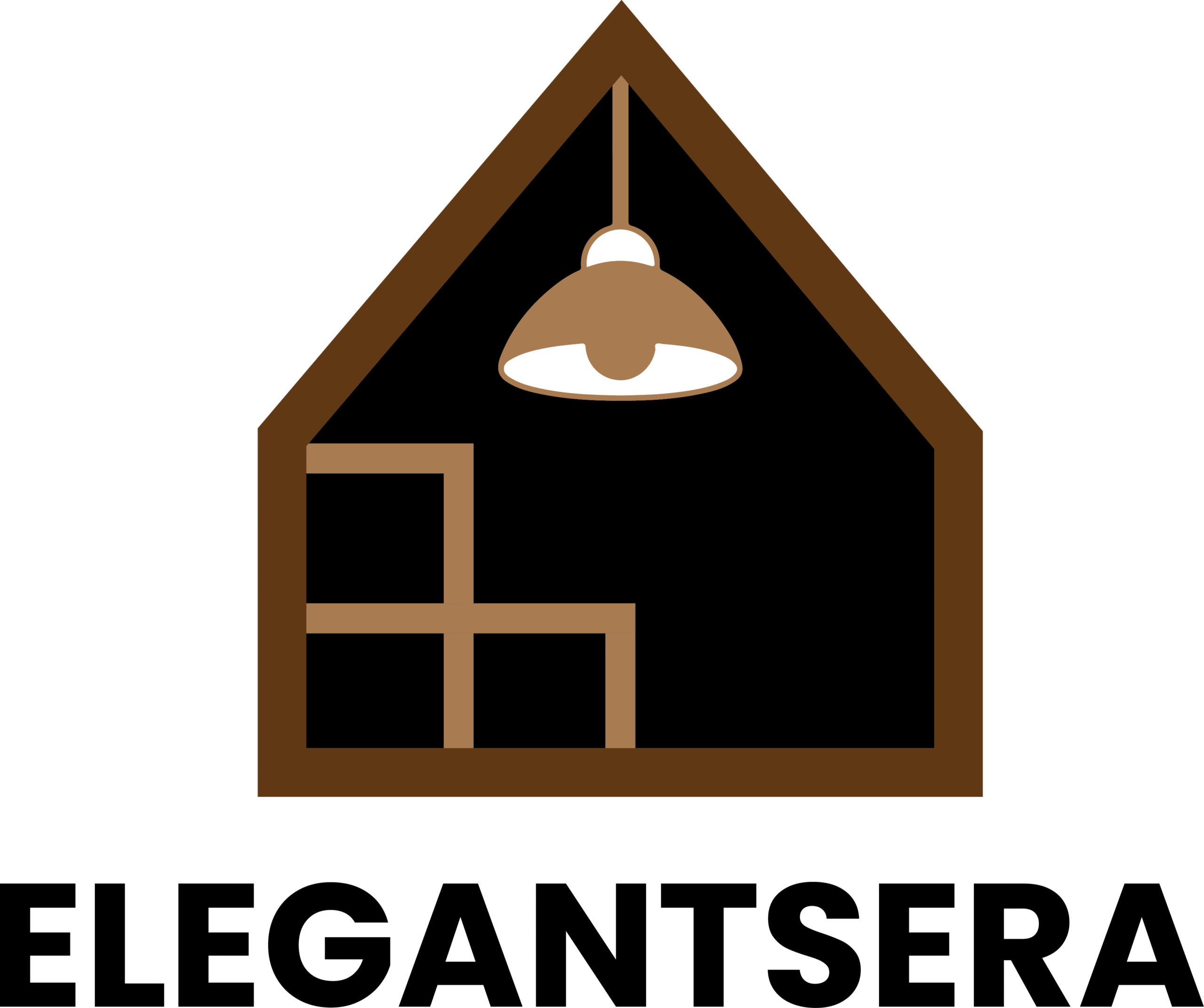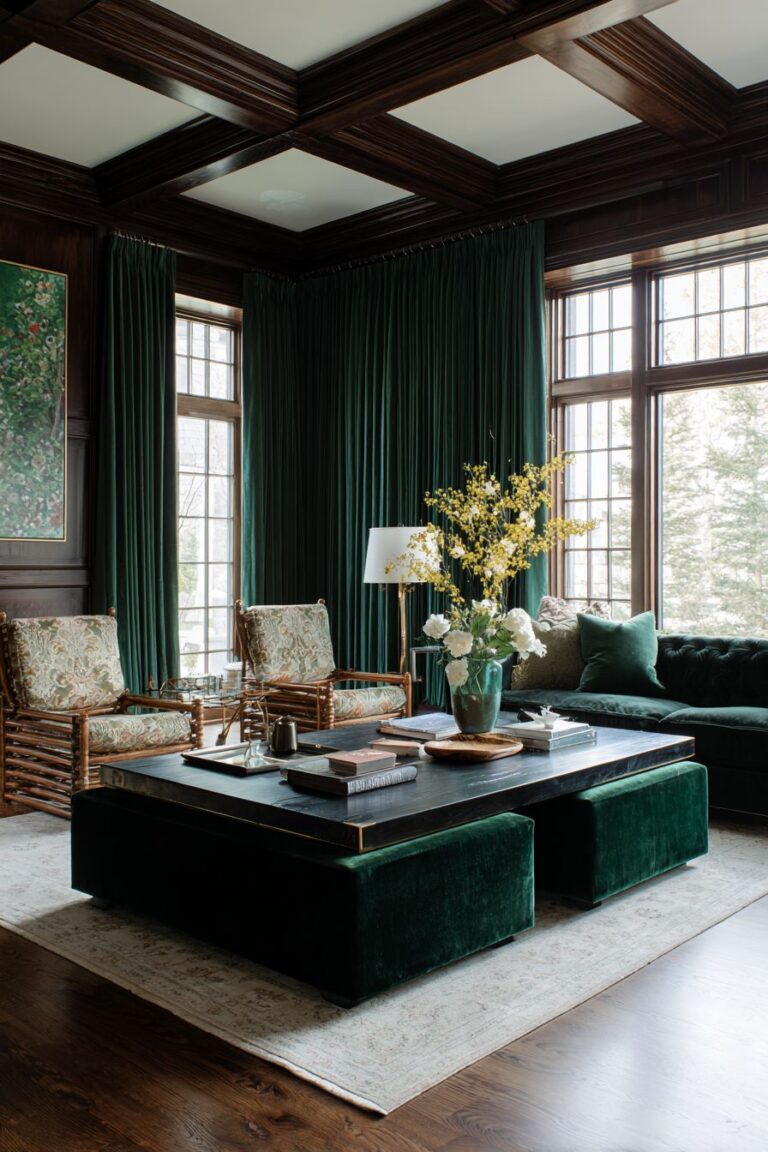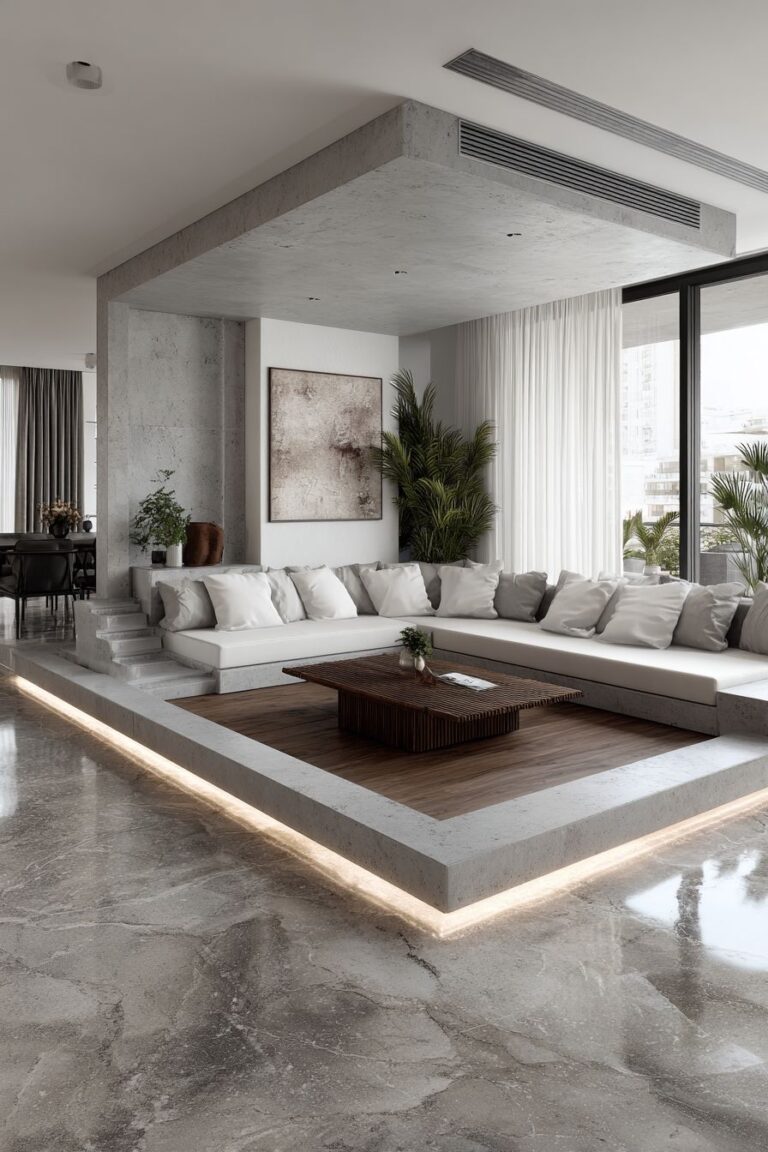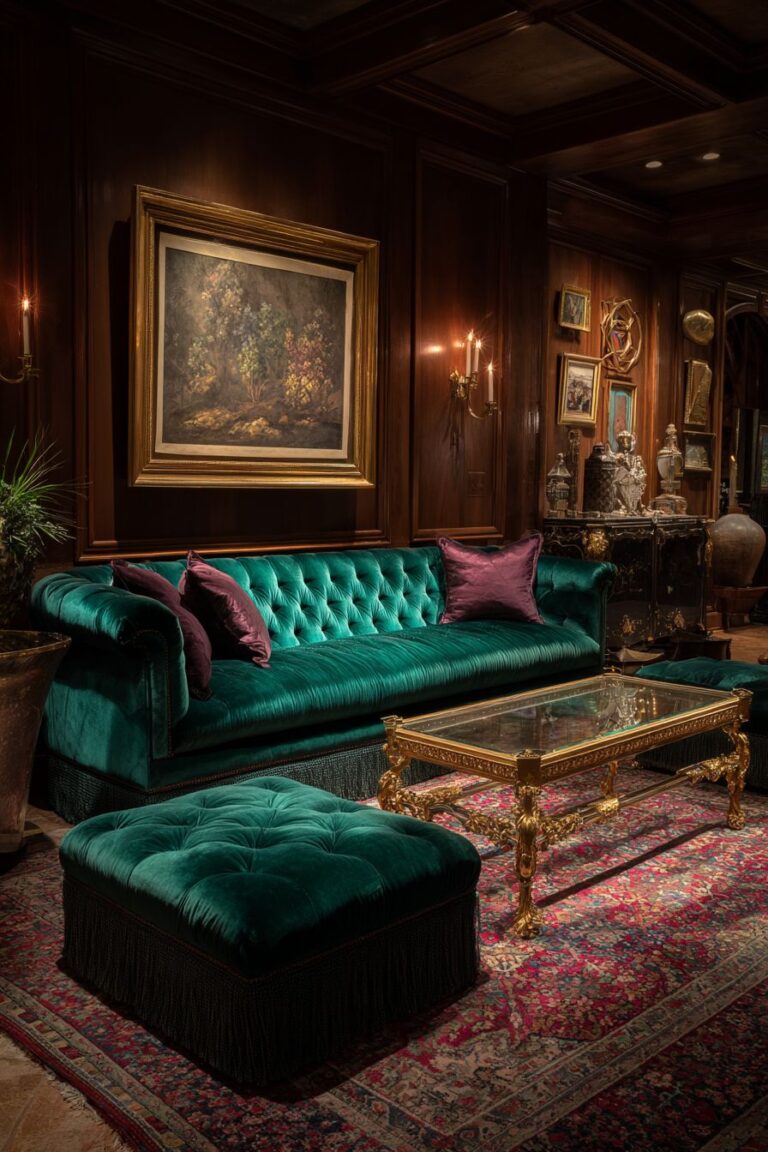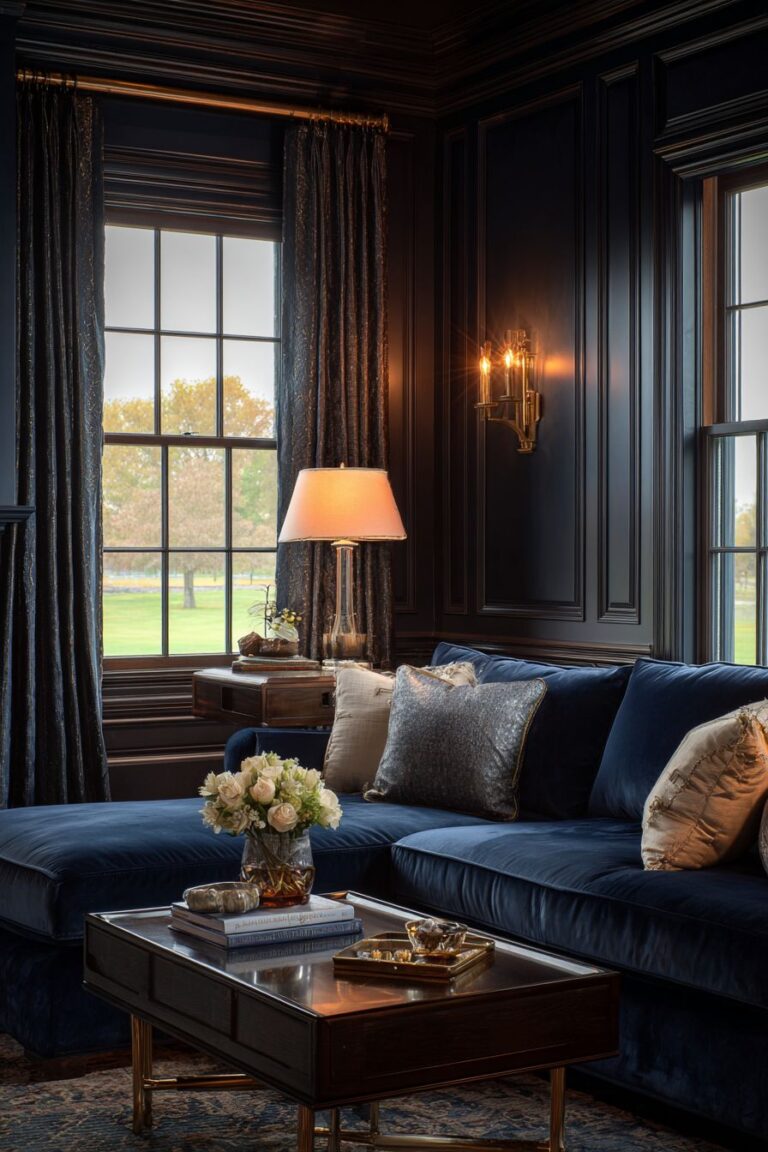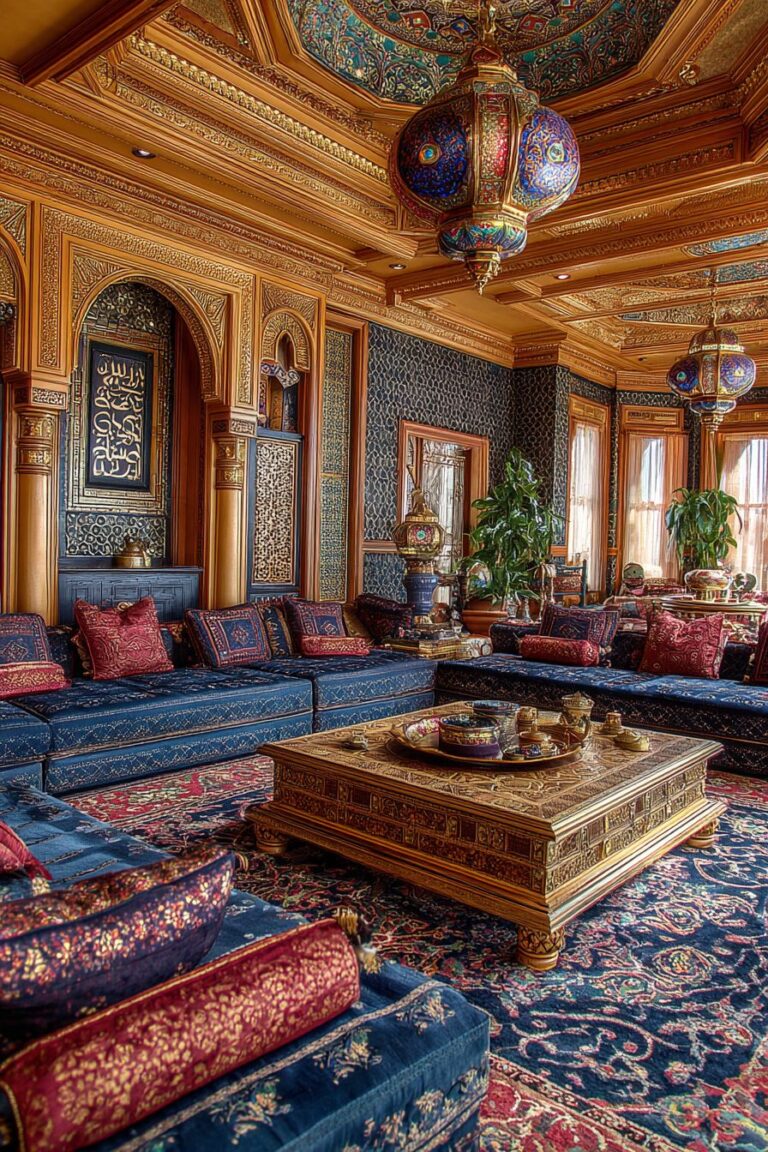20 Blue Living Room Ideas: Designs to Transform Your Space
The living room serves as the heart of every home, a sanctuary where families gather, conversations flow, and memories are created. The color choices we make in this central space profoundly impact not only the aesthetic appeal but also the emotional atmosphere and functionality of the room. Among the spectrum of design possibilities, blue emerges as an extraordinarily versatile and timeless choice that can adapt to virtually any interior design style. From the deepest navy to the softest powder blue, this remarkable color palette offers endless possibilities for creating spaces that are both visually stunning and emotionally resonant.
Blue living rooms have captured the imagination of homeowners and interior designers alike for their ability to evoke tranquility, sophistication, and creativity. This color connects us to nature through its associations with sky and water, bringing a sense of calm and expansiveness into our indoor environments. Whether you’re drawn to the bold drama of jewel-toned sapphires, the coastal serenity of aquamarine hues, or the subtle elegance of slate and steel blues, there’s a shade and style perfectly suited to your personal aesthetic and lifestyle needs.
In this comprehensive guide, we’ll explore twenty distinctive blue living room designs, each showcasing unique approaches to incorporating this beloved color into your home. From luxurious velvet sofas to casual coastal retreats, from traditional elegance to cutting-edge contemporary design, these carefully curated concepts demonstrate the remarkable range and adaptability of blue in interior spaces. You’ll discover practical design tips, material recommendations, and styling strategies that will inspire and guide you in creating your own beautiful blue living room sanctuary.
1. Navy Velvet Elegance with Brass Accents
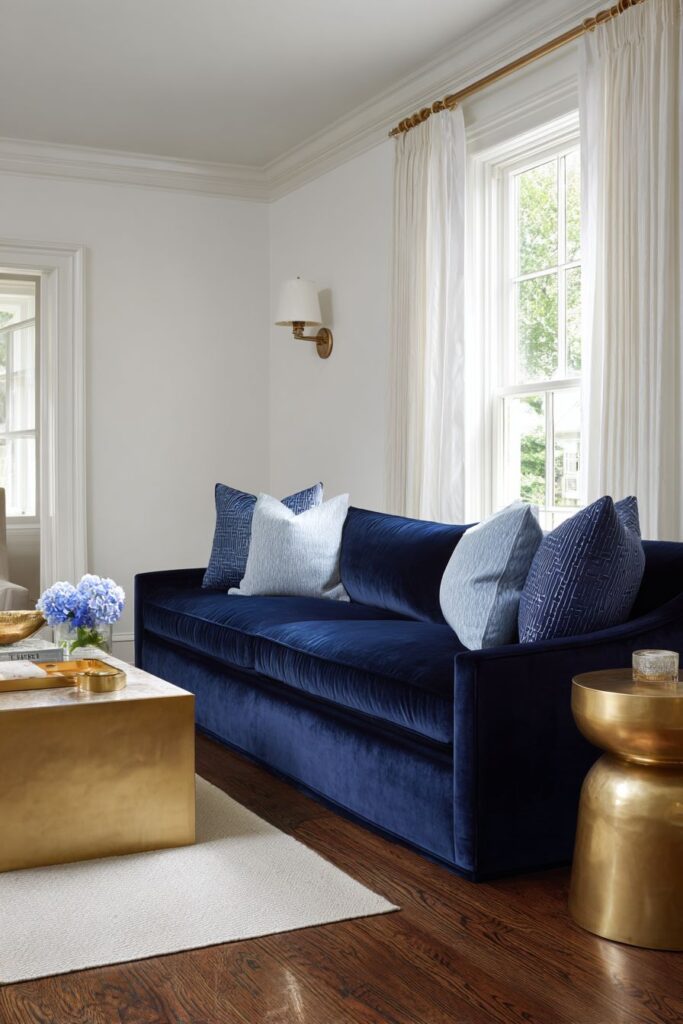
Step into a living room where luxury meets comfort through the commanding presence of a plush navy velvet sofa positioned against crisp white textured walls. This design celebrates the richness of deep blue upholstery, with the velvet’s inherent depth and sheen creating a focal point that draws the eye immediately upon entering the space. The interplay between the dark, sumptuous fabric and the bright, clean backdrop establishes a sophisticated contrast that feels both contemporary and timeless.
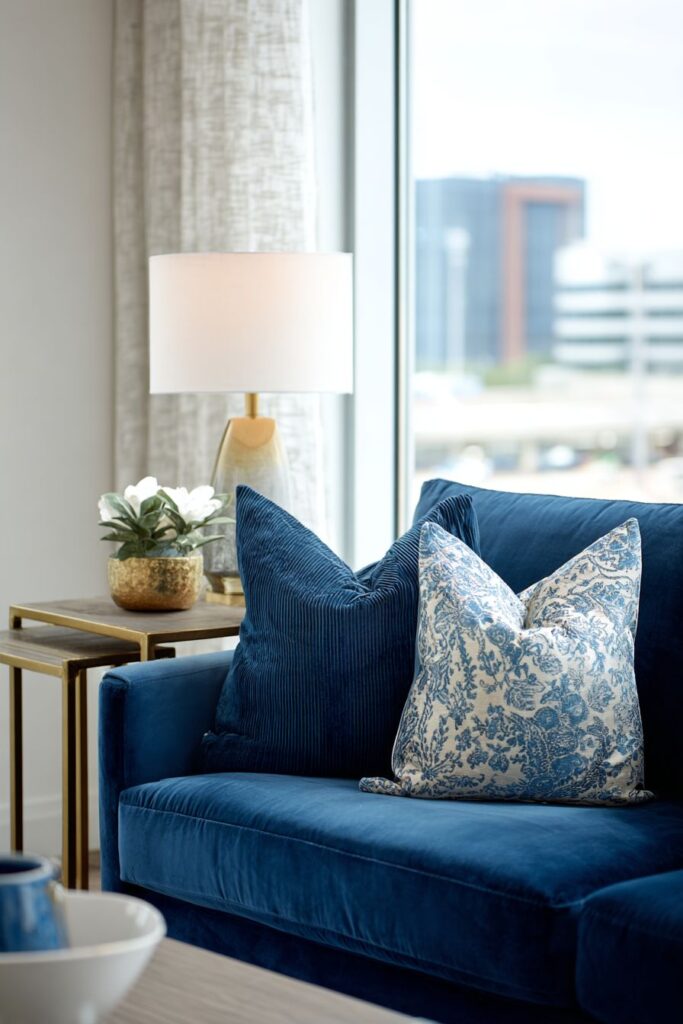
The warm wood flooring provides an essential grounding element, its natural tones creating a bridge between the cool blue upholstery and the neutral walls. Brass accent tables scattered throughout the space introduce metallic warmth that elevates the entire design scheme. These golden touches catch and reflect natural light streaming through sheer curtains, creating subtle sparkles that animate the room throughout the day. The curtains themselves serve a dual purpose, filtering harsh sunlight while maintaining the connection to the outdoors and allowing the room to feel open and airy.
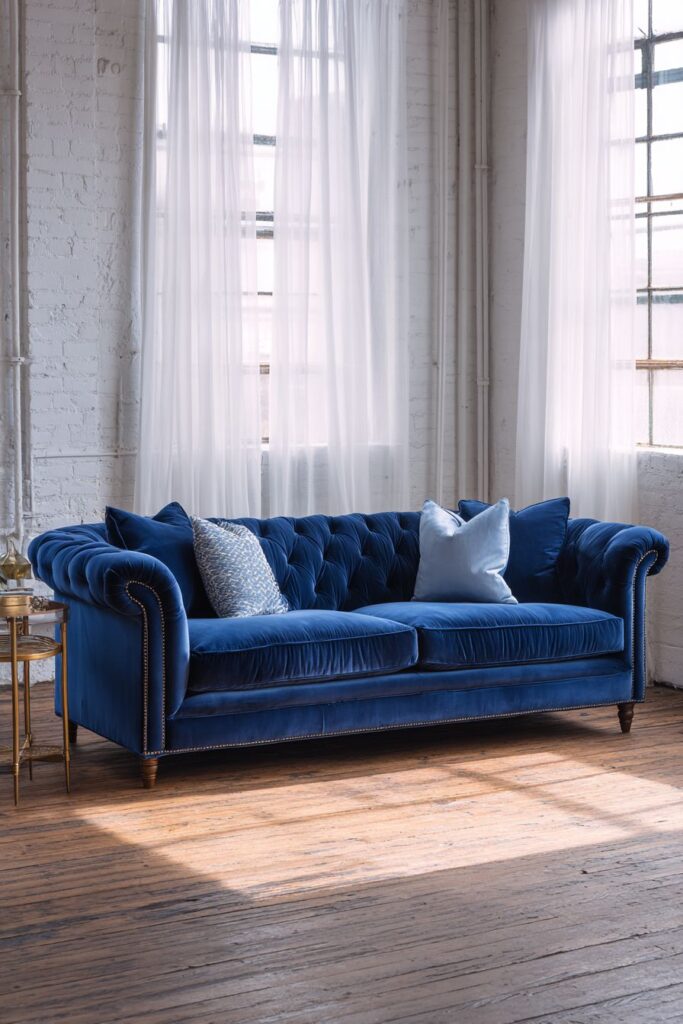
Layering is key in this design, particularly through the strategic use of decorative pillows in varying shades of blue from powder to indigo. This tonal variation prevents the color scheme from feeling flat or one-dimensional, instead creating depth and visual interest that rewards closer inspection. The range of blues creates a sophisticated gradient effect that adds complexity without introducing competing colors.

Key Design Tips:
- Invest in high-quality velvet upholstery that will maintain its luxurious appearance and resist crushing over time
- Position your sofa to maximize natural light exposure, which beautifully highlights velvet’s directional pile and creates dynamic visual interest
- Use brass fixtures and accessories with warm undertones rather than bright gold to maintain sophistication
- Layer multiple shades of blue through pillows, throws, and accessories to create depth and prevent monotony
- Keep walls neutral and bright to allow the navy upholstery to serve as the undisputed star of the space
2. Coastal Dreams: Light Blue Sectional Sanctuary
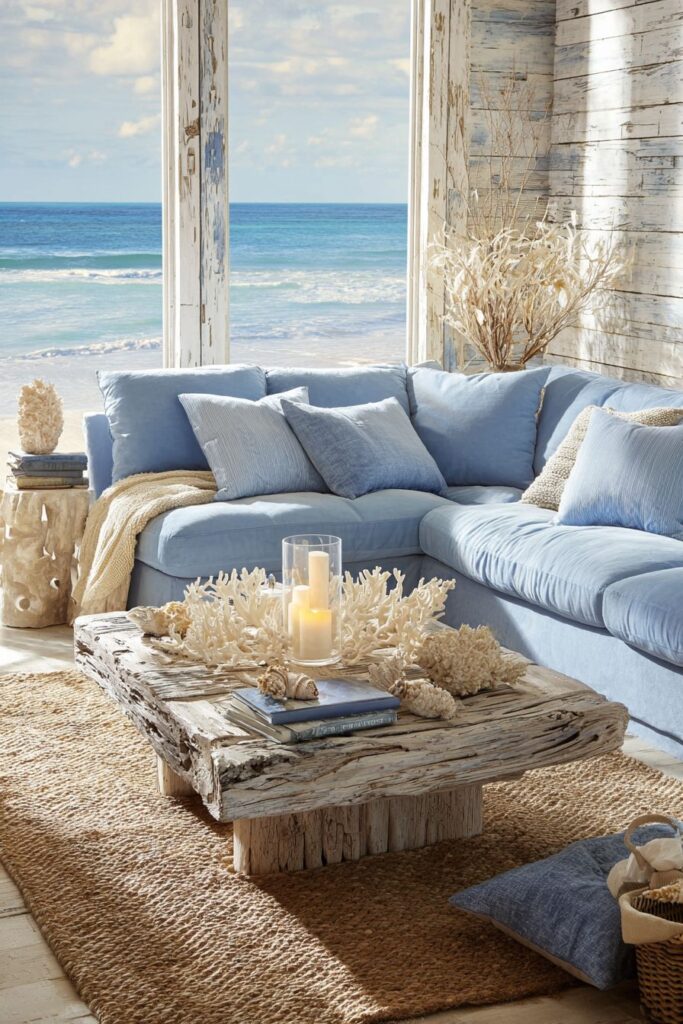
The coastal-inspired living room captures the essence of seaside living through its masterful use of light blue tones and natural materials. A generous light blue sectional sofa anchors the space, its relaxed silhouette and comfortable proportions inviting family and guests to sink in and unwind. The sofa’s soft hue evokes the color of shallow coastal waters on a sunny day, immediately establishing the room’s connection to oceanic themes.
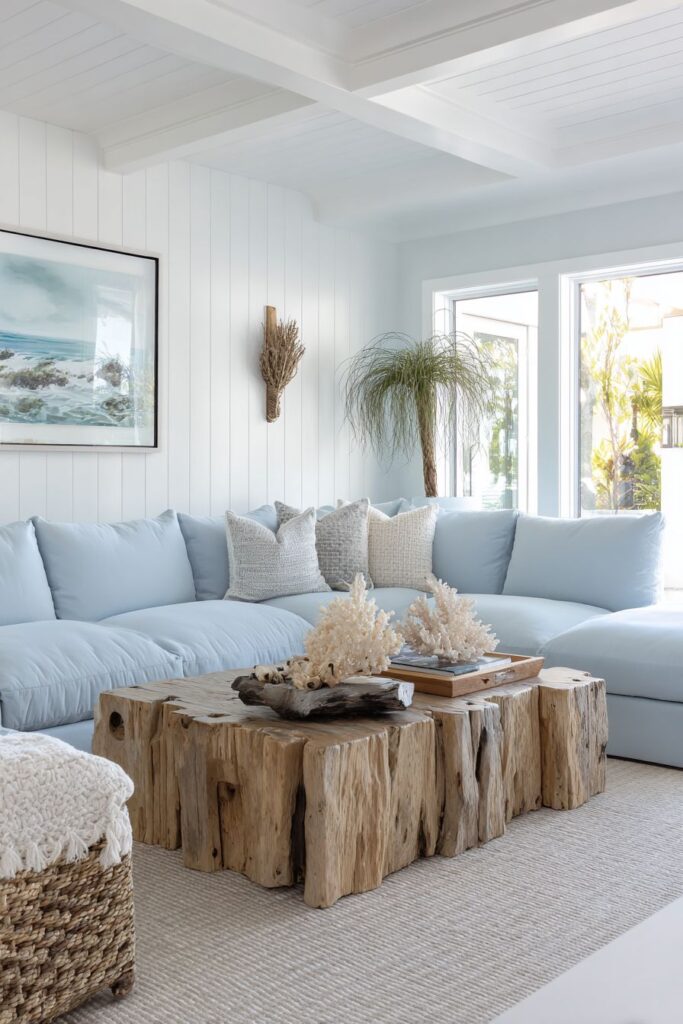
Central to this design is the weathered driftwood coffee table, a sculptural piece that brings organic beauty and tactile interest into the space. The silvered wood, shaped by wind and waves, tells a story of nature’s artistry while providing functional surface area for books, beverages, and decorative displays. Against the white shiplap accent wall, these natural elements shine, creating a clean yet textured backdrop that enhances rather than competes with the furnishings.
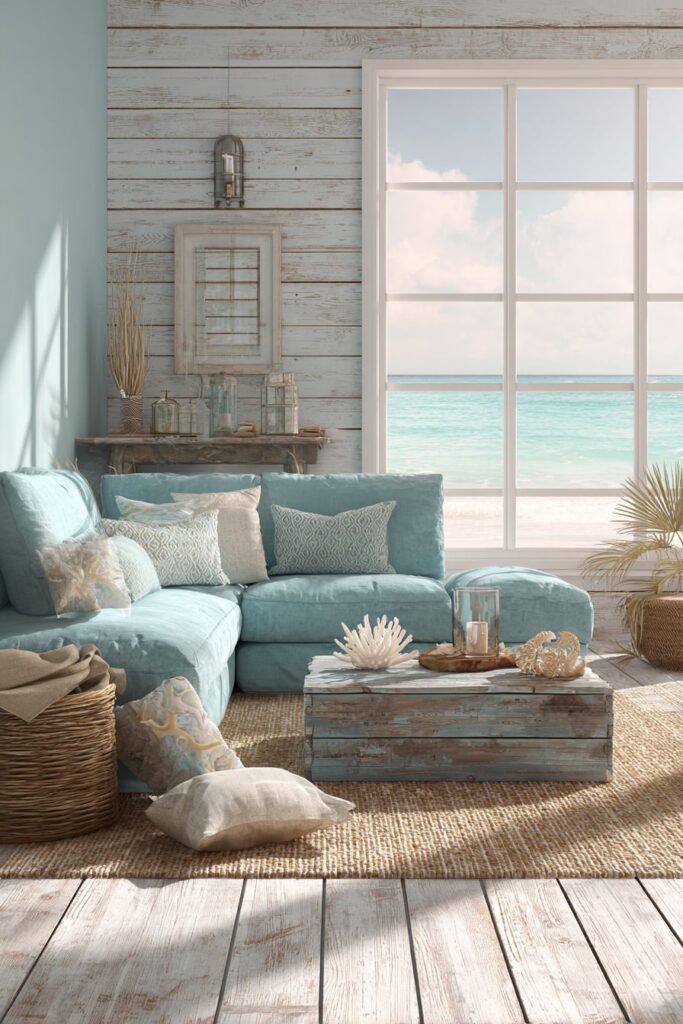
Textured jute rugs ground the seating area, their natural fibers adding warmth and dimensional interest underfoot while maintaining the coastal aesthetic. These rugs serve both practical and design purposes, defining the conversation area while introducing an earthy element that balances the cooler blue tones. Decorative elements throughout the space include carefully curated coral and shell accessories in natural tones, each piece contributing to the beach-house narrative without veering into kitsch or cliché.
The true magic of this coastal living room lies in how natural light floods through large windows, creating an airy atmosphere that feels perpetually sun-drenched. The layered blue tones throughout the space, from the palest sky blue in accent pillows to deeper aquamarine in throw blankets, create subtle variations that mimic the ever-changing colors of ocean water.
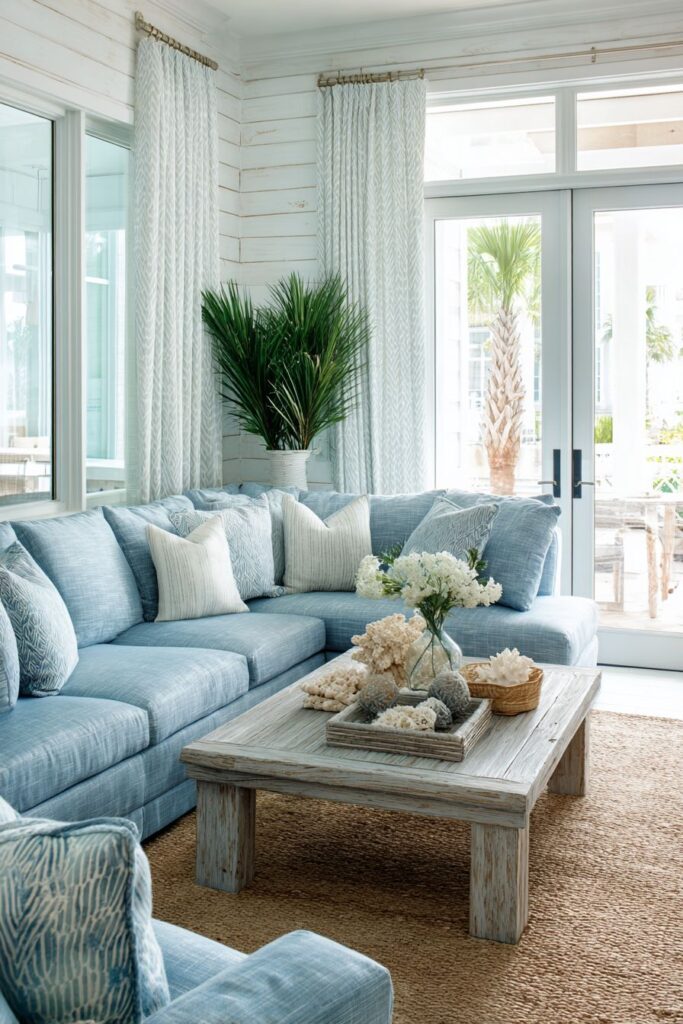
Key Design Tips:
- Choose a sectional sofa in a light, washable fabric that can withstand the relaxed lifestyle of coastal living
- Incorporate authentic driftwood pieces rather than manufactured imitations for genuine character and conversation-starting appeal
- Layer different textures through natural fiber rugs, linen fabrics, and woven accessories to prevent the light color palette from feeling flat
- Keep decorative accessories natural and understated, allowing collected beach treasures to tell their own stories
- Maximize natural light through sheer window treatments that filter rather than block sunlight
- Use white or cream as a secondary color to enhance the airy, expansive feeling characteristic of beach houses
3. Modern Sophistication: Teal Accent Wall Impact

Contemporary design finds its voice in this modern blue living room where a striking teal blue accent wall commands attention without overwhelming the space. This bold architectural move creates an immediate focal point, serving as a dramatic backdrop for the low-profile grey sofa positioned strategically in front of it. The combination of teal and grey demonstrates sophisticated color theory in action, with the cooler grey tones allowing the vibrant teal to truly shine while maintaining overall visual balance.
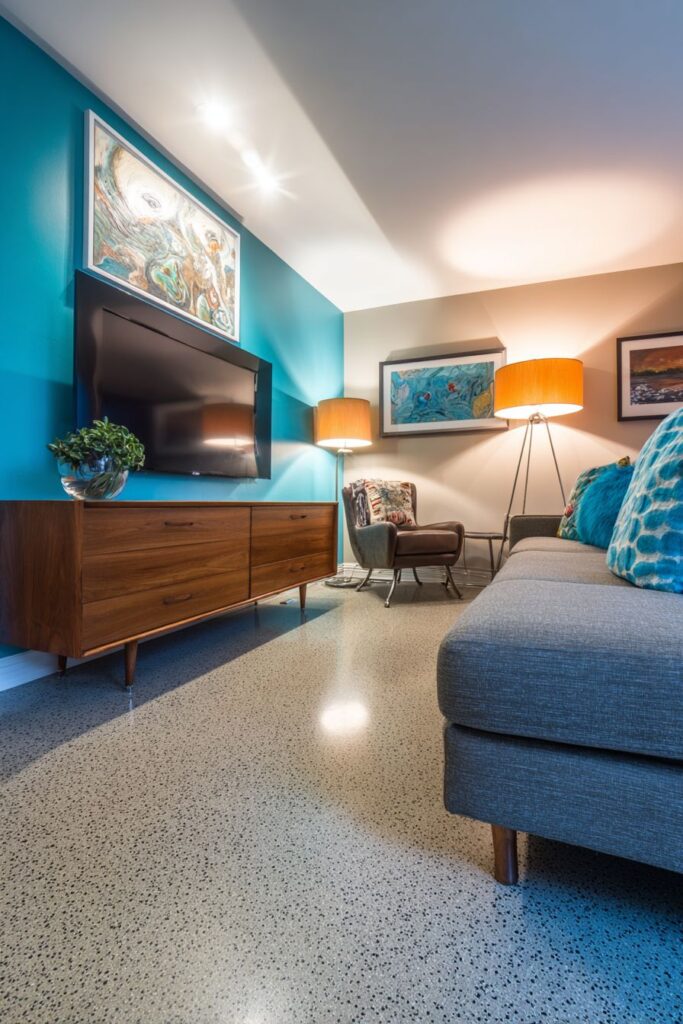
The mid-century modern walnut media console represents both form and function, its clean lines and warm wood tones providing essential visual weight along the lower portion of the accent wall. Above it, a carefully curated gallery wall features artwork with strategic blue color pops that tie back to the accent wall while introducing additional visual interest and personality into the space. This layered approach to wall decoration creates depth and prevents the bold wall color from feeling like an isolated design decision.
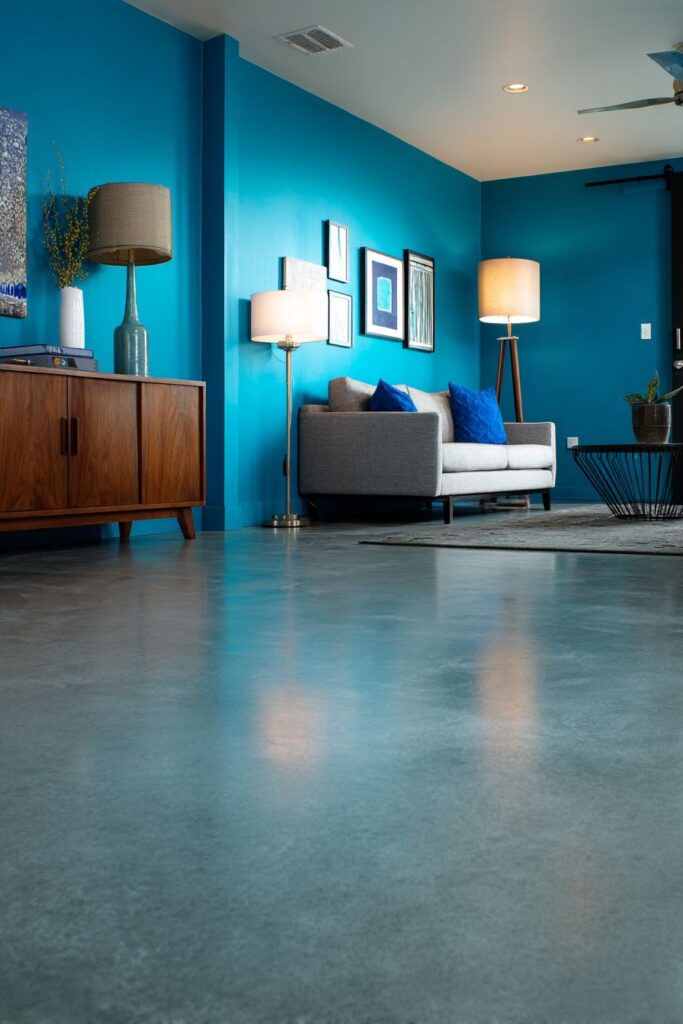
Polished concrete floors make a strong contemporary statement, their smooth, reflective surface bouncing light around the room and contributing to the modern industrial aesthetic. Strategically placed floor lamps provide ambient lighting that creates dramatic shadows and highlights, essential for setting mood in the evening hours when natural light fades. The geometric forms and metallic finishes of these lighting fixtures reinforce the modern design vocabulary established by the furniture selections.
Blue throw pillows on the grey sofa create a cohesive connection between the major design elements, bridging the neutral upholstery and the bold wall color. This repetition of blue throughout the space at different scales and intensities creates a sense of intentionality and design cohesion that distinguishes thoughtfully designed spaces from merely decorated rooms.

Key Design Tips:
- Test your chosen teal paint color in different lighting conditions before committing, as blue tones can shift dramatically between natural and artificial light
- Position your accent wall strategically behind a major furniture piece to create a built-in focal point
- Balance bold wall colors with neutral upholstery to prevent visual overwhelm and maintain design flexibility
- Choose a low-profile sofa that doesn’t compete with the accent wall for attention
- Incorporate warm wood tones to prevent cool color schemes from feeling cold or unwelcoming
- Use gallery walls with strategic color coordination to reinforce your primary design choices
- Select polished or reflective flooring materials to maximize light distribution in modern spaces
4. Timeless Tradition: Royal Blue Chesterfield Elegance
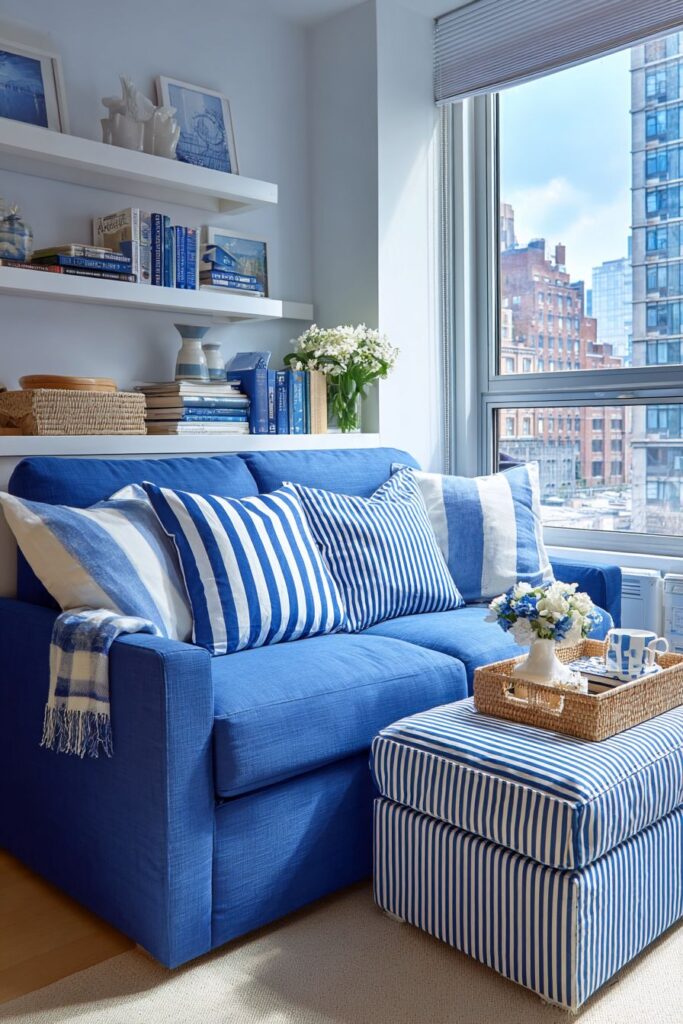
Traditional design reaches its zenith in this formal living room where a royal blue tufted Chesterfield sofa serves as the undisputed centerpiece. The deep, saturated blue upholstery represents classic sophistication, its button-tufted details and rolled arms showcasing the craftsmanship that defines traditional furniture design. This is not merely a sofa but a statement piece that anchors the entire room’s aesthetic and establishes expectations for quality and refinement throughout the space.
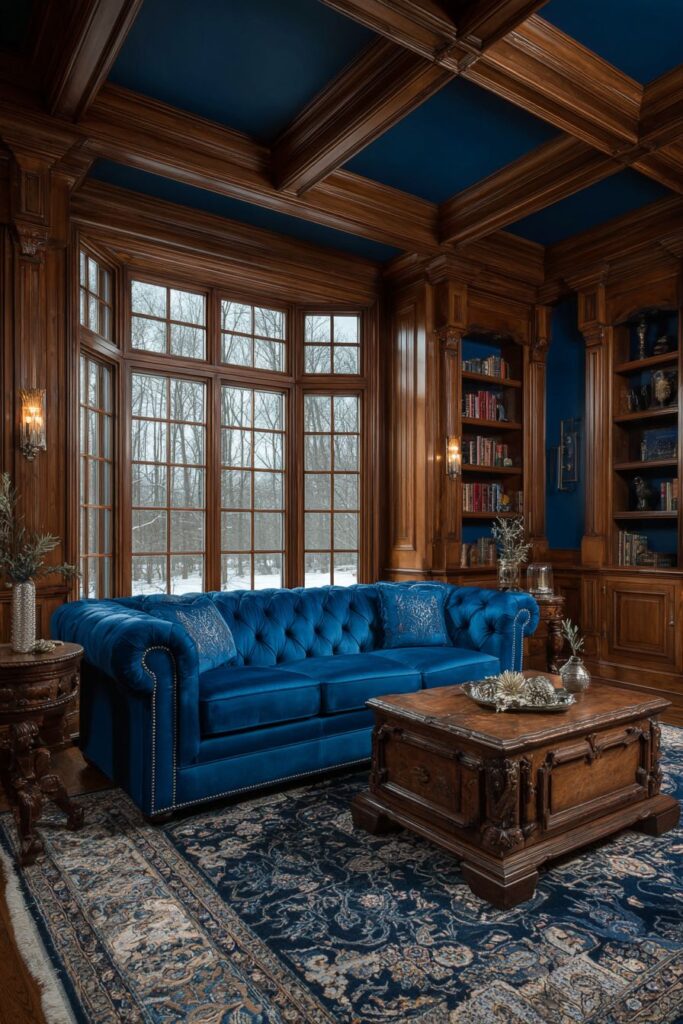
An antique Persian rug featuring intricate blue and cream patterns spreads beneath the seating area, its complex design and rich history adding layers of visual interest and cultural depth to the room. The interplay between the rug’s pattern and the solid blue upholstery creates a dynamic relationship where each element enhances the other. Dark wood side tables flanking the sofa provide practical surface area while introducing the rich, warm tones that characterize traditional interiors.

Built-in bookshelves frame the space, their dark wood construction and formal styling providing both storage and architectural gravitas. These floor-to-ceiling shelving units, filled with leather-bound volumes and decorative objects, speak to a life of learning and refinement. Crown molding adds architectural detail that elevates the room beyond simple decoration into the realm of true interior architecture, where every element serves both aesthetic and structural purposes.
Natural light streams through bay windows, their classic architectural form allowing light to enter from multiple angles while creating a charming alcove that could serve as additional seating or a display area for plants. The sunlight highlights the deep blue upholstery, revealing the subtle variations in tone and the quality of the fabric, while illuminating the classical design elements that make this room timelessly appealing.
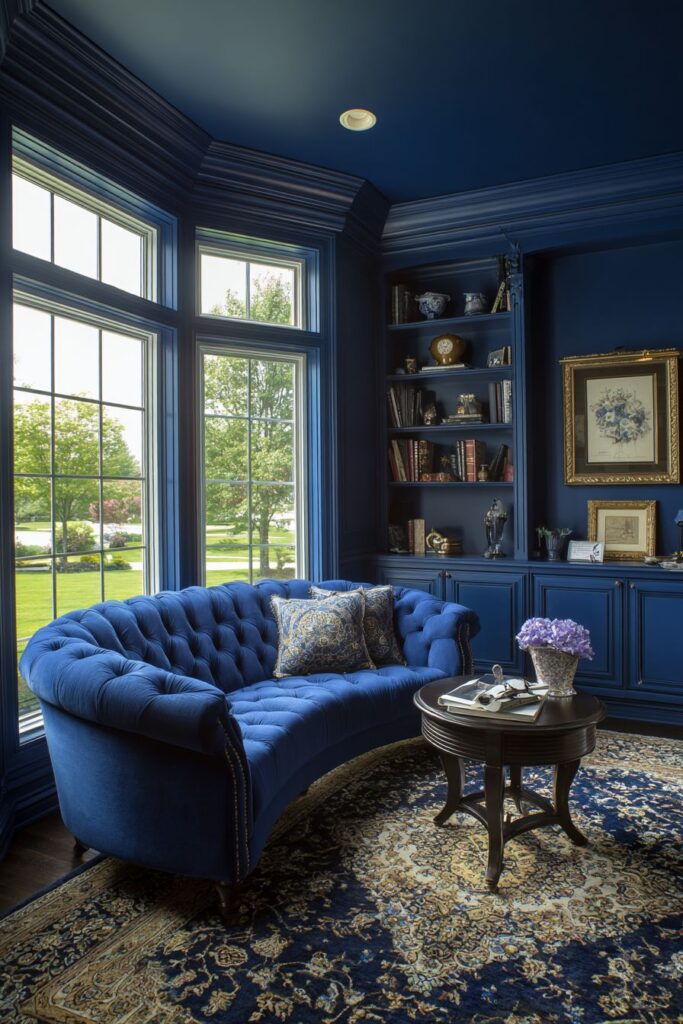
Key Design Tips:
- Invest in authentic Chesterfield design rather than budget reproductions to ensure lasting quality and proper proportions
- Choose royal blue or navy upholstery in premium fabrics that will age gracefully and resist wear
- Layer antique or high-quality reproduction rugs that complement rather than compete with bold upholstery colors
- Incorporate dark wood furniture and built-ins to establish the warm, rich palette characteristic of traditional design
- Add architectural details like crown molding and wainscoting to create authentic period character
- Maximize natural light through traditional window treatments that frame rather than obscure views
- Display meaningful collections and quality accessories that tell a story and demonstrate personal taste
5. Scandinavian Simplicity: Slate Blue Minimalism

Nordic design philosophy comes to life in this Scandinavian-inspired living room where less truly becomes more. A slate blue linen sofa with clean lines and exposed wooden legs embodies the hygge principle of functional comfort without unnecessary ornamentation. The muted blue-grey tone represents the quintessential Scandinavian color palette, evoking the subtle hues of Nordic skies and coastal waters while maintaining the neutrality essential to minimalist design.

Light oak flooring establishes the warm, natural foundation that prevents minimalist spaces from feeling cold or sterile. The pale wood’s gentle grain and honey tones create visual interest without pattern or complexity, allowing the eye to rest and the mind to find calm. Minimalist white walls provide the perfect backdrop for this understated aesthetic, their pristine surfaces creating a gallery-like environment where every object becomes significant through its placement and purpose.
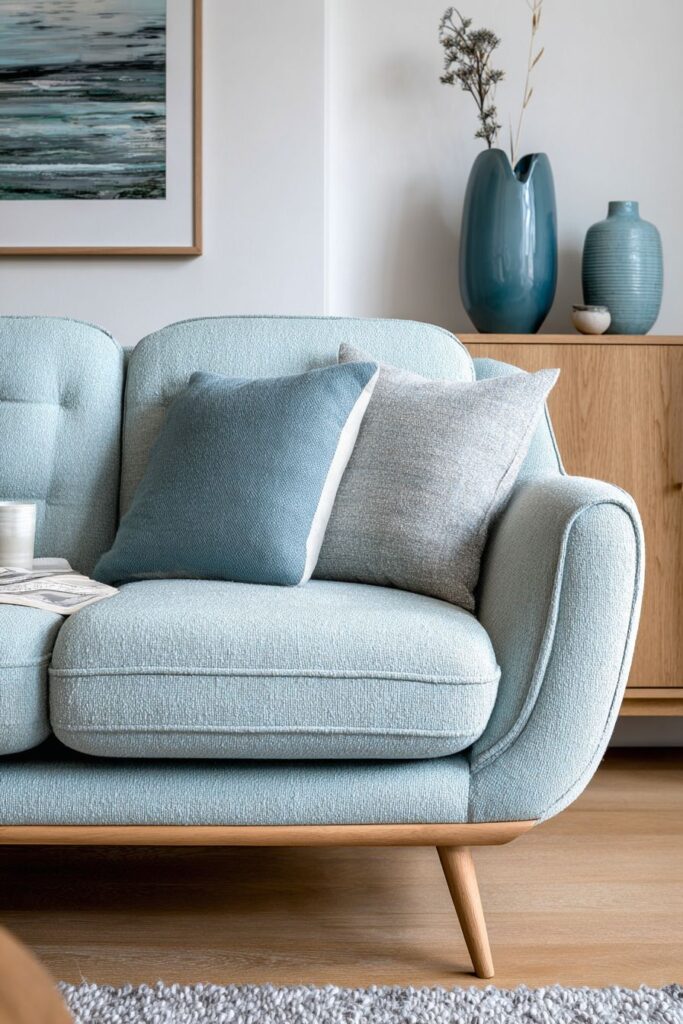
Simple blue ceramic vases positioned with deliberate care demonstrate the Scandinavian principle that decorative objects should be both beautiful and functional. These pieces, perhaps handcrafted by local artisans, bring subtle color variation and organic form into the carefully edited space. Understated artwork, likely featuring abstract forms or natural subjects rendered in minimal color palettes, adds personality without clutter or visual noise.
A wool area rug in soft grey-blue tones defines the seating area while introducing essential texture and warmth underfoot. The natural fiber and muted color maintain design cohesion while providing acoustic softening and physical comfort. Material texture becomes paramount in minimalist design, where color and pattern are restrained, and the quality and character of each surface assumes greater importance in creating a rich sensory experience.
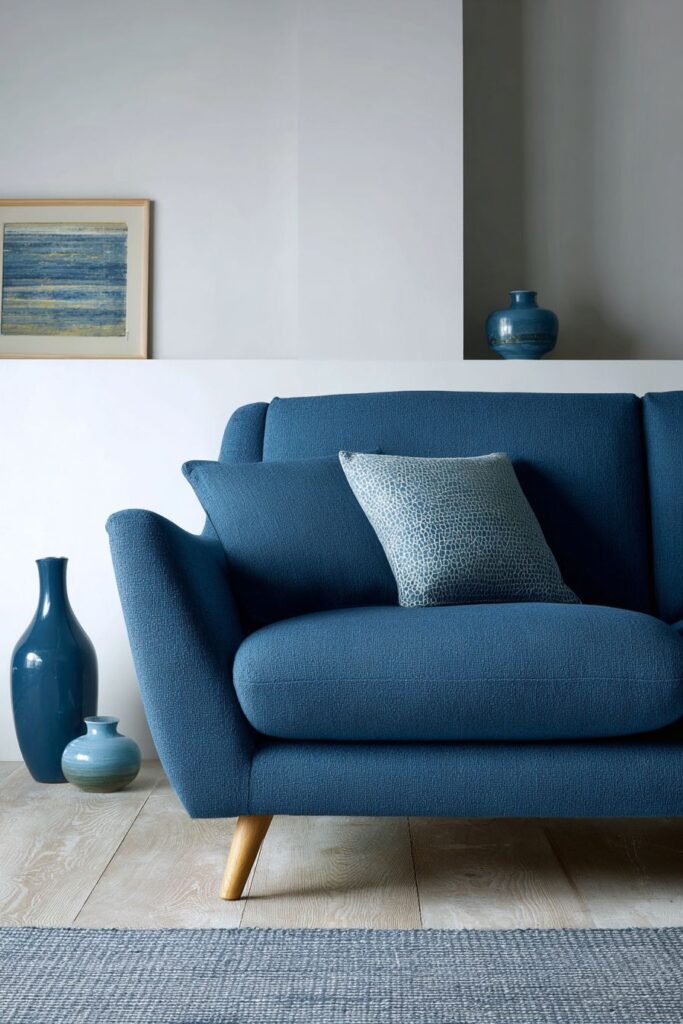
Key Design Tips:
- Select furniture with exposed wooden elements to maintain connection with natural materials central to Scandinavian design
- Choose linen upholstery for its natural texture, breathability, and honest, unadorned aesthetic
- Limit color palette to muted blues, greys, whites, and natural wood tones for authentic Nordic restraint
- Invest in fewer, higher-quality pieces rather than filling the space with numerous accessories
- Incorporate natural light maximization through minimal window treatments or none at all
- Select wool or natural fiber textiles for rugs and soft furnishings to add warmth and texture
- Display only meaningful objects, allowing each piece room to breathe and make its own statement
- Maintain visible floor space and resist the urge to fill every corner, embracing the beauty of empty space
6. Small Space Solutions: Powder Blue Compact Living
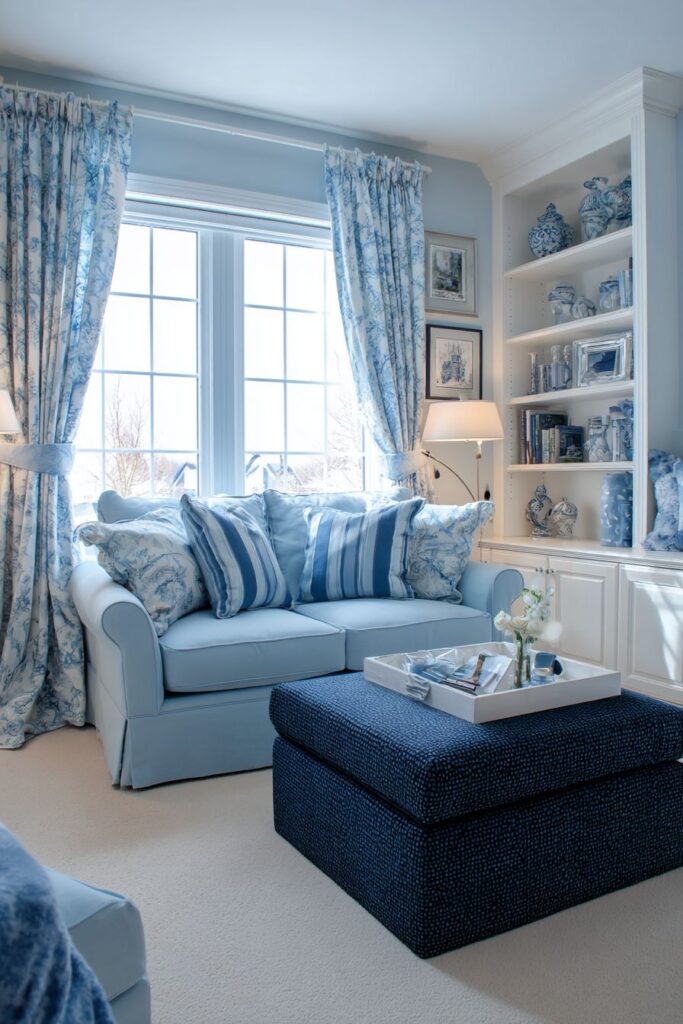
Maximizing limited square footage requires both creativity and strategic design thinking, as beautifully demonstrated in this small blue living room. A compact powder blue loveseat anchors the space without overwhelming it, its soft, gentle hue creating an illusion of spaciousness rather than closing in the room. The loveseat’s smaller scale proves that comfort and style need not be sacrificed in tight quarters, while its light color reflects rather than absorbs light, essential for maintaining brightness in smaller rooms.
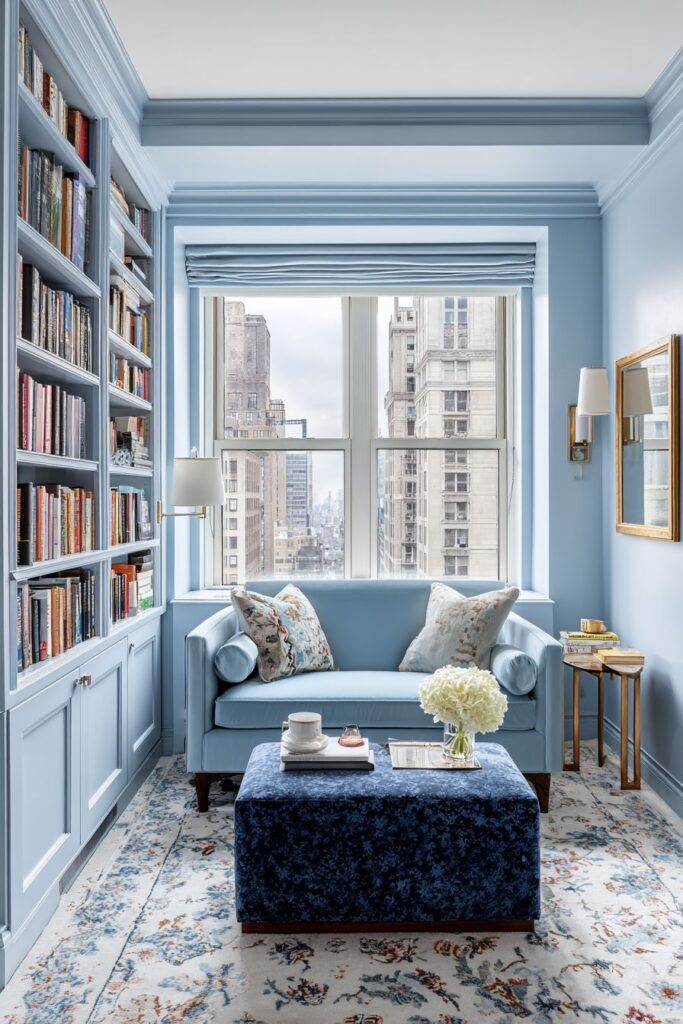
Built-in floating shelves painted in matching blue tones create vertical storage that draws the eye upward, making ceilings appear higher and the room more expansive. This clever integration of storage and color consistency demonstrates how thoughtful design can turn practical necessities into aesthetic assets. The shelves provide display space for books, plants, and decorative objects without consuming precious floor space, keeping traffic patterns clear and the room feeling uncluttered.
Mirrors strategically placed throughout the space perform double duty, both reflecting light to brighten the room and creating the illusion of depth and expanded square footage. Positioning mirrors opposite windows maximizes this effect, essentially doubling the perceived natural light while creating intriguing reflections that add visual complexity to compact spaces.

A multi-functional ottoman in navy blue fabric serves as both coffee table and hidden storage, exemplifying the smart furniture choices essential to small space living. This versatile piece can hold extra blankets, books, or entertainment accessories while providing surface area for drinks and display, and can even serve as additional seating when guests visit. The deeper navy color grounds the lighter powder blue elements, creating necessary visual weight and color contrast.
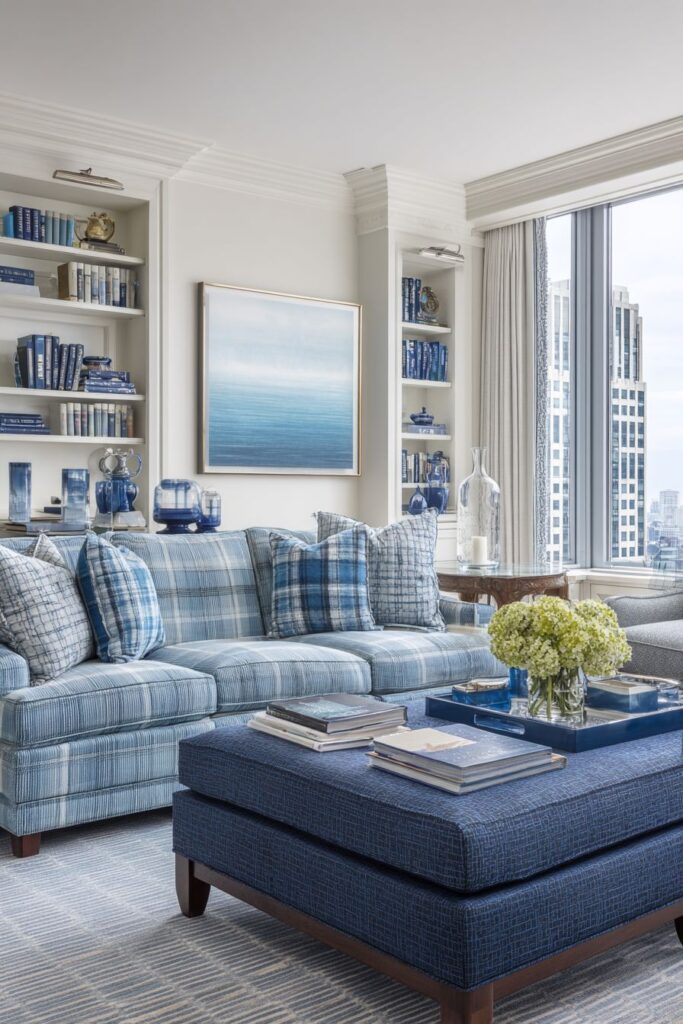
Key Design Tips:
- Choose light blue upholstery in smaller scales to maintain airiness while providing adequate seating
- Install floating shelves and wall-mounted storage to preserve valuable floor space
- Paint built-in storage the same color as walls to create seamless integration rather than visual interruption
- Position mirrors strategically to reflect natural light and create the illusion of expanded space
- Select multi-functional furniture pieces that serve several purposes, maximizing utility in limited square footage
- Maintain a cohesive color scheme throughout to prevent visual fragmentation that makes small spaces feel chaotic
- Keep window treatments minimal or eliminate them entirely to maximize natural light penetration
- Choose furniture with exposed legs rather than skirted pieces to maintain visual lightness and show more floor
7. Eclectic Expression: Sapphire Blue Collected Character
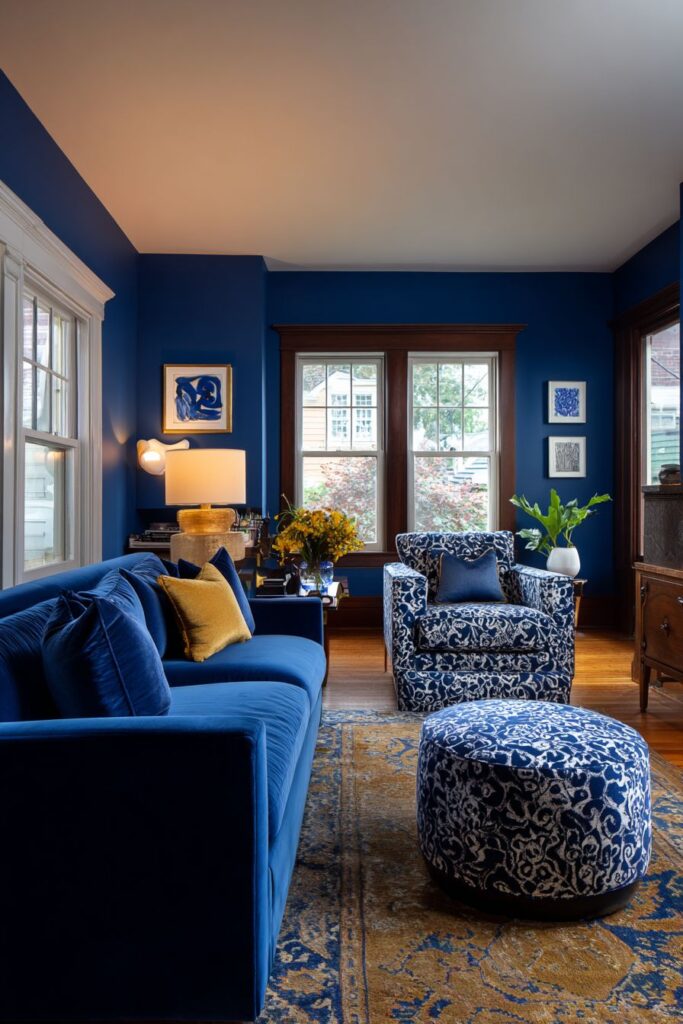
The eclectic living room celebrates individuality and collected charm through its masterful blending of vintage and modern elements. A jewel-tone sapphire blue velvet sofa serves as the luxurious anchor, its rich, saturated color providing a bold foundation upon which layers of personality and history can build. This isn’t minimalism or matchy-matchy coordination, but rather a thoughtfully curated space that reflects genuine interests, travels, and accumulated treasures.

Mismatched blue patterned armchairs demonstrate the eclectic philosophy that perfection lies in imperfection and that harmony can emerge from diversity. One chair might feature a traditional damask pattern while another sports a modern geometric print, yet both incorporate blues that relate to the sapphire sofa, creating cohesion through color even as pattern and style vary wildly. This approach requires confidence and a discerning eye, but the results feel authentic and deeply personal.
A Moroccan-style rug in blues and golds anchors the seating arrangement, its intricate patterns and luxurious color combination adding exotic flair and visual richness to the floor plane. The gold tones introduce warmth that prevents the blue-heavy palette from feeling cold, while the rug’s complex design creates a foundation that can support the visual variety happening above it.
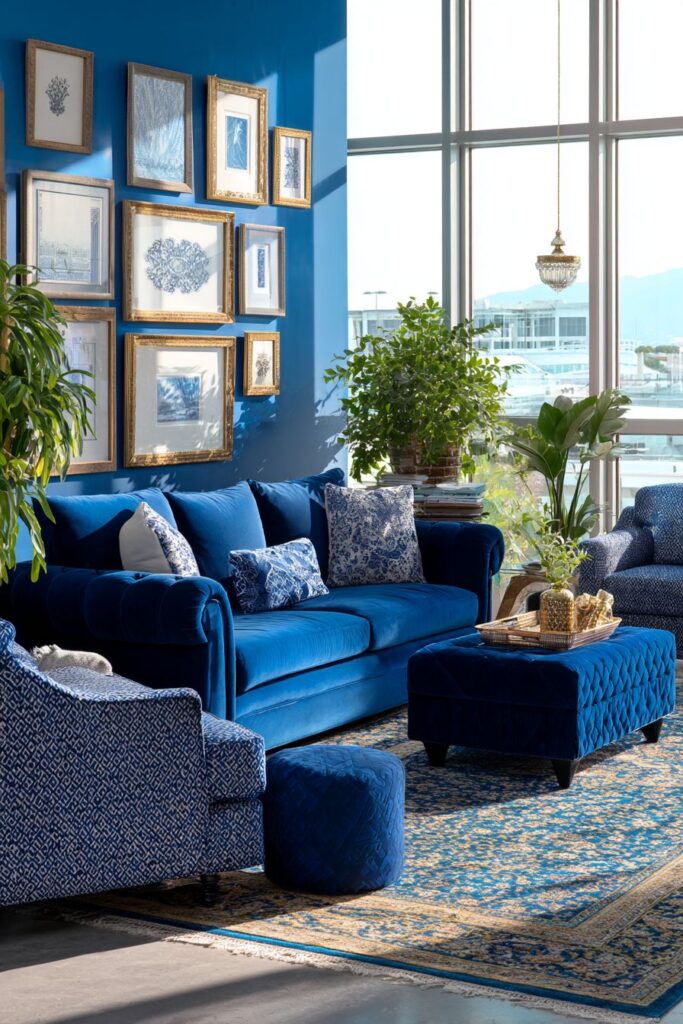
The gallery wall exemplifies eclectic design at its finest, featuring varied frames in different finishes, sizes, and styles surrounding blue-toned artwork that ranges from abstract expressionism to vintage photography to contemporary illustration. This collected approach to wall art tells a story of a life lived curiously, where art is acquired over time based on genuine appreciation rather than coordinated in a single shopping trip. Natural and ambient lighting work together to create warm atmosphere, with table lamps, floor lamps, and perhaps string lights combining to create layered illumination that can be adjusted for different moods and occasions.

Key Design Tips:
- Start with one anchor piece in a saturated blue tone, then build your eclectic collection around it
- Mix patterns freely but maintain color cohesion through repeated blues in varied shades
- Collect furniture and accessories over time rather than purchasing everything at once for authentic collected character
- Include pieces from different eras, cultures, and design movements to create genuine eclecticism
- Layer rugs, textiles, and patterns to build visual richness and prevent the space from feeling flat
- Create gallery walls with varied frames and artwork rather than uniform matted prints
- Combine metallic finishes like brass, copper, and gold to add warmth and luminous variety
- Trust your instincts and include pieces you genuinely love rather than following rigid design rules
8. Reading Retreat: Peacock Blue Literary Corner
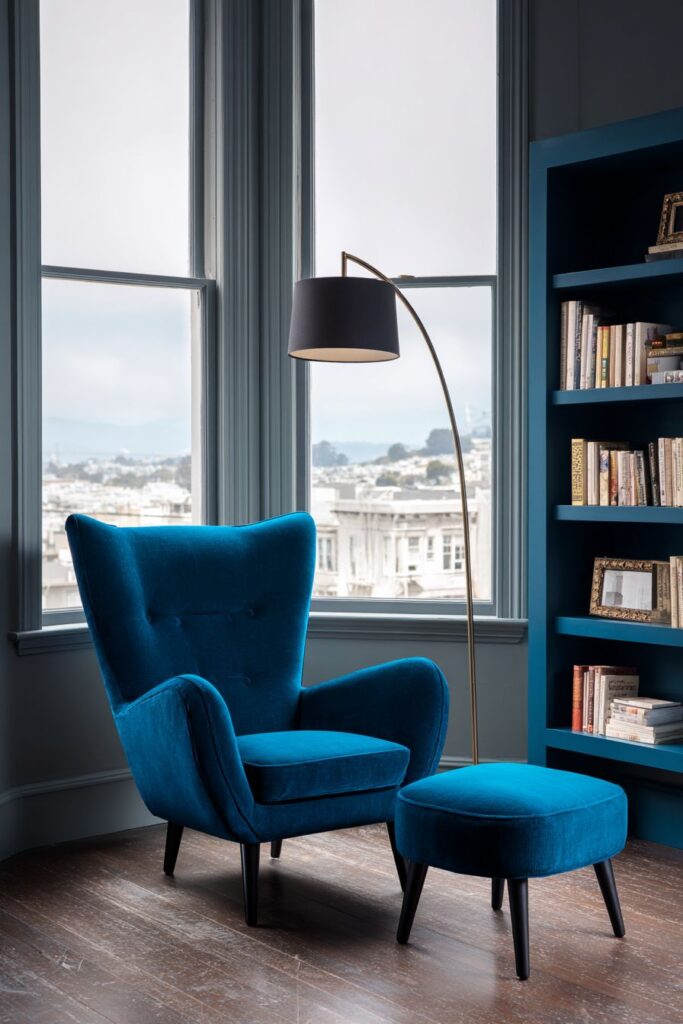
Every book lover dreams of the perfect reading nook, and this blue living room corner delivers that fantasy with style and substance. A cozy peacock blue wingback chair positioned near floor-to-ceiling windows creates an intimate sanctuary within the larger living space. The chair’s rich blue-green hue evokes the iridescent beauty of peacock feathers, providing both visual drama and the embrace of high sides and wings that create a sense of enclosure and focus ideal for losing oneself in literature.
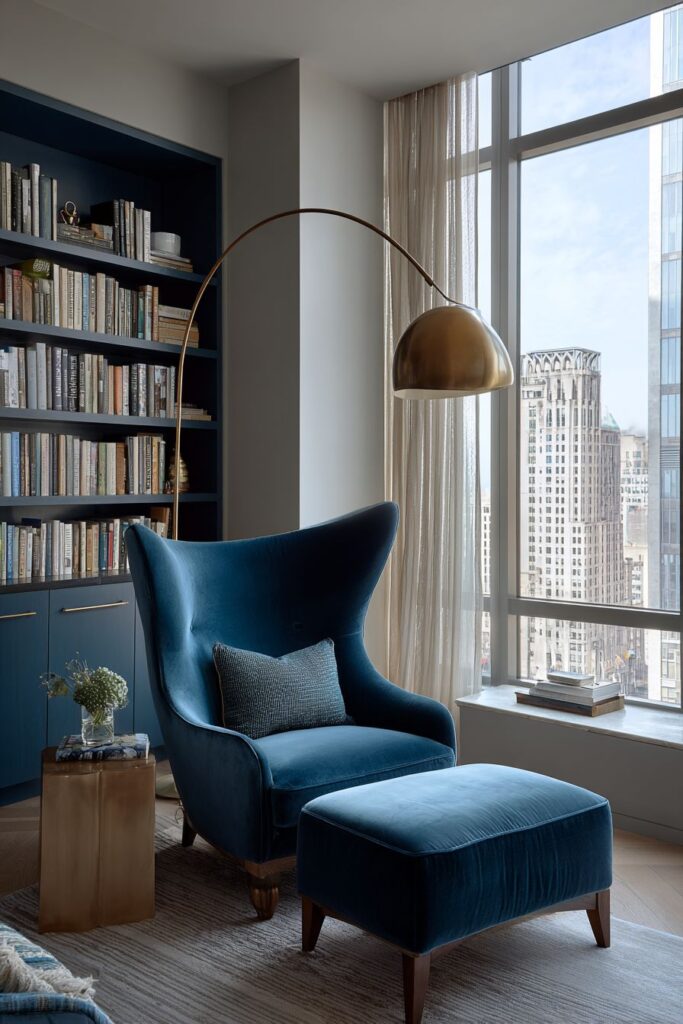
The matching ottoman extends the seating, providing essential leg support for extended reading sessions while offering a surface for stacking current reads or placing a teacup during breaks. This coordinated pair creates a cohesive mini-environment within the room, a dedicated zone that announces its purpose clearly. Built-in bookshelves in navy blue house a carefully curated collection, the darker blue creating a sophisticated backdrop that makes book spines pop while maintaining the room’s color cohesion.
A brass arc floor lamp curves gracefully over the reading chair, its adjustable positioning allowing perfect task lighting for reading regardless of time of day or natural light conditions. The warm brass finish adds metallic interest and reflects light in a way that creates ambient glow even when focused downward for reading. This is practical luxury, where beautiful design serves genuine functional needs.

Soft grey walls allow the blue furniture to stand out without competition, creating a neutral envelope that makes the reading nook feel both integrated into the larger room and special in its own right. The grey provides visual rest, ensuring that the eye travels to the more saturated blues of the chair, ottoman, and built-in shelving. Natural light streaming through nearby windows creates gentle highlights on the blue upholstery texture, revealing the depth and quality of the fabric while providing optimal reading light during daylight hours.
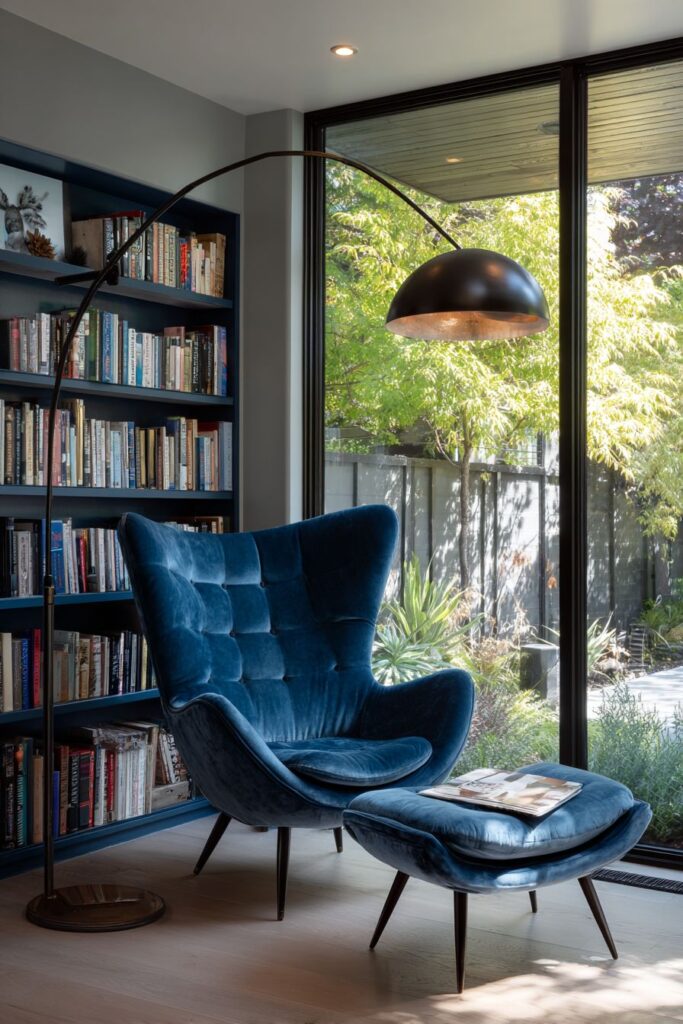
Key Design Tips:
- Position reading chairs near windows to maximize natural light during prime reading hours
- Choose wingback or high-sided chair designs that create a sense of enclosure and focus
- Invest in quality task lighting with adjustable positioning for optimal reading illumination
- Include an ottoman or footstool for comfort during extended reading sessions
- Build or install bookshelves within reach of the reading chair for easy access to your collection
- Select upholstery in rich, saturated blues that create a cozy, enveloping feeling
- Keep surrounding walls neutral to allow the reading nook to become a distinct focal point
- Add small side tables for beverages, reading glasses, and bookmarks within easy reach
9. Farmhouse Comfort: Denim Blue Casual Living
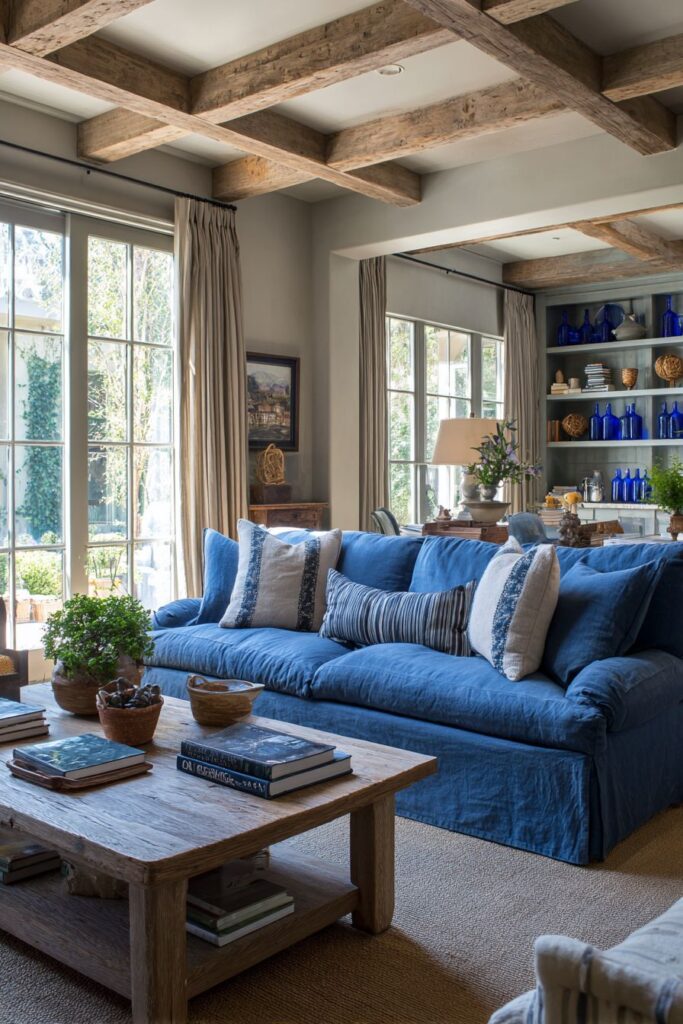
Rustic farmhouse charm meets comfortable family living in this relaxed blue living room designed for real life. A distressed denim blue slipcovered sofa embodies the casual elegance of farmhouse style, its washable linen texture providing both aesthetic appeal and practical functionality for households with children, pets, or simply active lifestyles. The soft, faded blue evokes well-loved denim jeans, bringing an inherently comfortable and approachable feeling into the space.
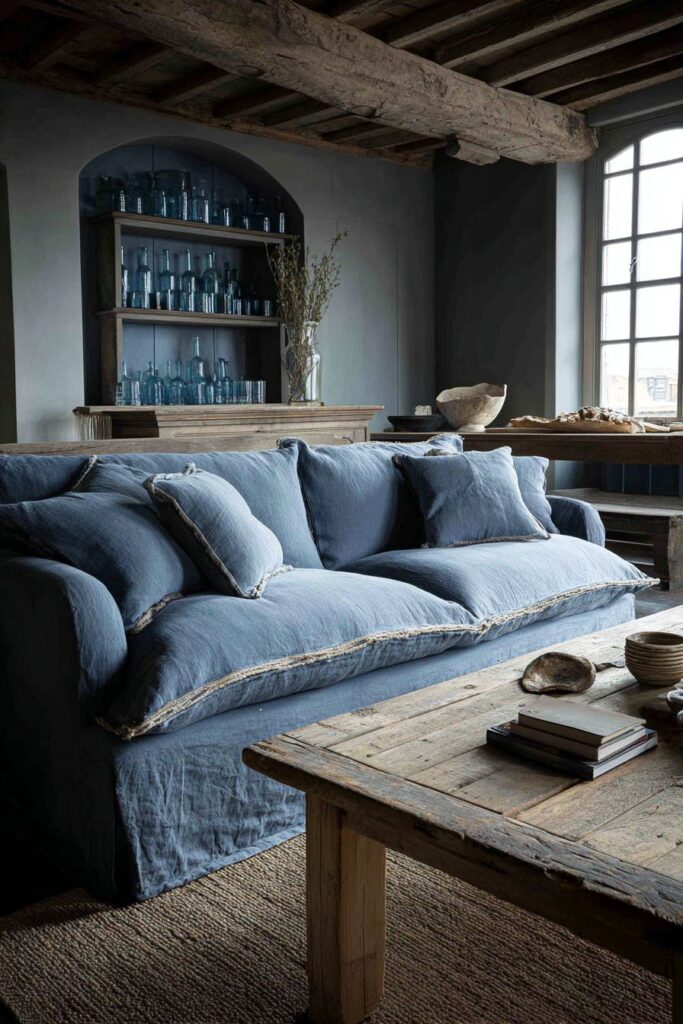
Reclaimed wood beams crossing the ceiling provide architectural character and historical reference, their weathered surfaces telling stories of previous lives in barns or old buildings. These beams create striking contrast against pale blue-grey walls, their dark, rich tones grounding the otherwise light and airy color palette. The combination of rustic wood and soft blue creates the quintessential farmhouse aesthetic that feels both nostalgic and fresh.
Vintage blue glass bottles arranged on open shelving add charm and collected character without requiring significant investment or perfect styling. These bottles, perhaps found at flea markets or estate sales, catch and filter light beautifully while introducing varied shades of blue that complement the larger color scheme. Open shelving itself represents farmhouse practicality, displaying everyday items and treasured objects with equal honesty.

Natural fiber rugs layer beneath a salvaged wood coffee table, creating textural depth and defining the seating area while maintaining the organic, natural materials palette central to farmhouse design. The layering technique adds visual interest and allows for seasonal changes or easy replacement of the top rug layer without disturbing the entire floor covering. Golden hour lighting streaming through farmhouse windows creates the magic of this space, bathing everything in warm, honeyed light that transforms the cool blues into something deeply inviting and cozy.
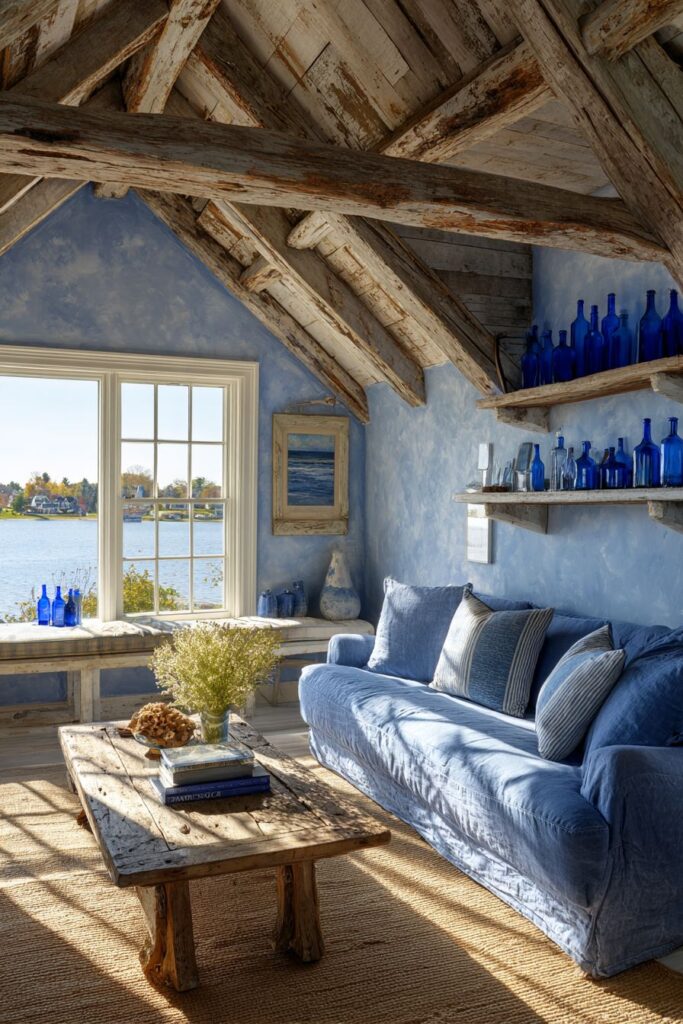
Key Design Tips:
- Choose slipcovered furniture in washable fabrics for authentic farmhouse practicality
- Embrace faded, distressed finishes in both furniture and accessories for genuine lived-in character
- Incorporate reclaimed wood elements through beams, coffee tables, or wall treatments
- Select pale blue-grey wall colors that provide subtle color while maintaining brightness
- Display collected vintage items like glass bottles or pottery rather than new coordinated accessories
- Layer natural fiber rugs for texture and flexible design options
- Install or retain traditional farmhouse windows that maximize natural light
- Include open shelving to display everyday items and create accessible storage
10. Luxe Living: Curved Sapphire Velvet Statement
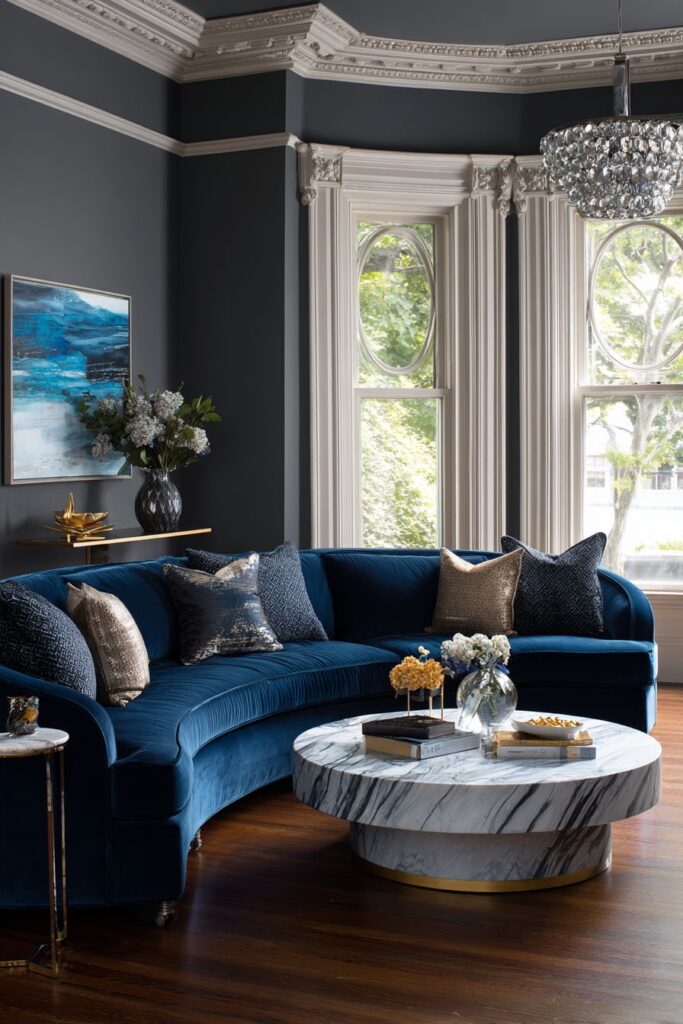
Luxury takes center stage in this opulent living room where a curved sapphire blue velvet sectional makes an unforgettable statement. The sophisticated curved form represents contemporary furniture design at its finest, with flowing lines that invite social interaction and create visual sculpture within the space. The rich sapphire hue, deep and jewel-toned, catches light along the curves, creating dimensional interest and highlighting the sumptuous quality of the velvet upholstery.

A marble coffee table with dramatic gold veining provides a luxurious counterpoint to the blue upholstery, its cool, smooth surface and natural patterning representing the intersection of nature and refinement. The gold veining in the marble creates an organic connection to the brass accents scattered throughout the room, establishing a cohesive metallic palette that adds warmth and luminosity to the cool blue tones.
Walls painted in sophisticated slate blue create an enveloping atmosphere, a technique that requires confidence but delivers dramatic results. Rather than using neutral walls to showcase furniture, this approach commits fully to blue as the defining characteristic of the space, creating a jewel-box effect where every surface reinforces the color choice. The monochromatic approach, utilizing multiple shades and saturations of blue, creates depth and sophistication beyond what contrasting colors might achieve.
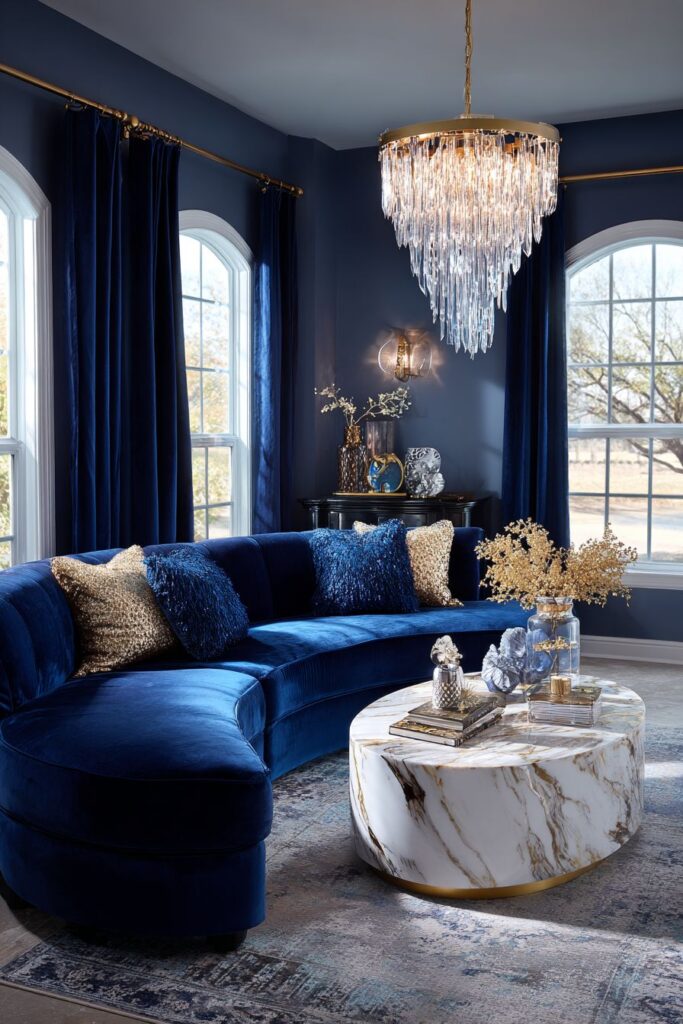
A crystal chandelier provides glamorous overhead lighting, its facets catching and dispersing light throughout the space like captured diamonds. This traditional luxury lighting choice pairs beautifully with brass accents in floor lamps, picture lights, and decorative accessories, creating a mixed-metal approach that feels current rather than matchy. The carefully balanced lighting throughout the room ensures that the rich textures and jewel-tone palette remain visible and impressive from morning through evening.
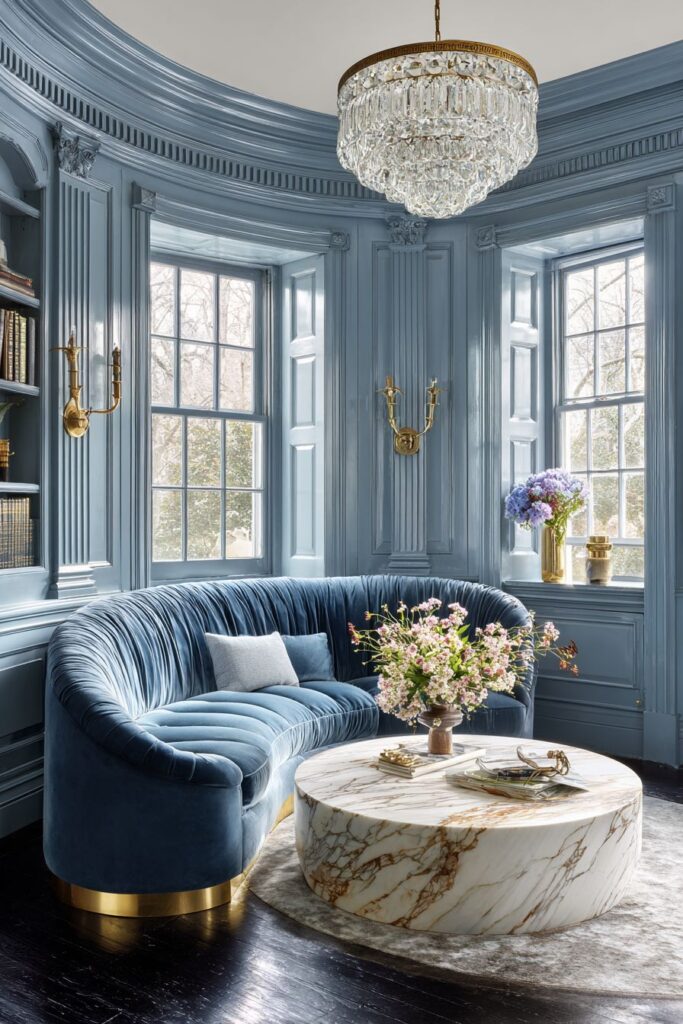
Key Design Tips:
- Invest in curved or sculptural furniture pieces that serve as art objects in their own right
- Choose premium velvet upholstery in saturated jewel tones for maximum luxury impact
- Select marble or stone surfaces with dramatic veining to add natural pattern and visual interest
- Consider enveloping wall colors in similar tones to your upholstery for cohesive sophistication
- Layer lighting through chandeliers, floor lamps, and table lamps for flexible ambiance
- Mix metallic finishes like brass and crystal for contemporary glamour
- Commit to quality over quantity, choosing fewer pieces in premium materials
- Maintain clean lines and uncluttered surfaces to allow luxury materials to shine
11. Bohemian Blues: Indigo Floor Sofa Lounge

Free-spirited bohemian design embraces relaxed living and global influences in this unconventional blue living room. A low-profile indigo blue floor sofa creates casual, grounded seating that breaks from Western furniture conventions and invites guests to settle in for long, comfortable conversations. The deep indigo color connects to traditional textile dyeing practices from cultures worldwide, bringing a sense of authenticity and handcrafted heritage into the space.
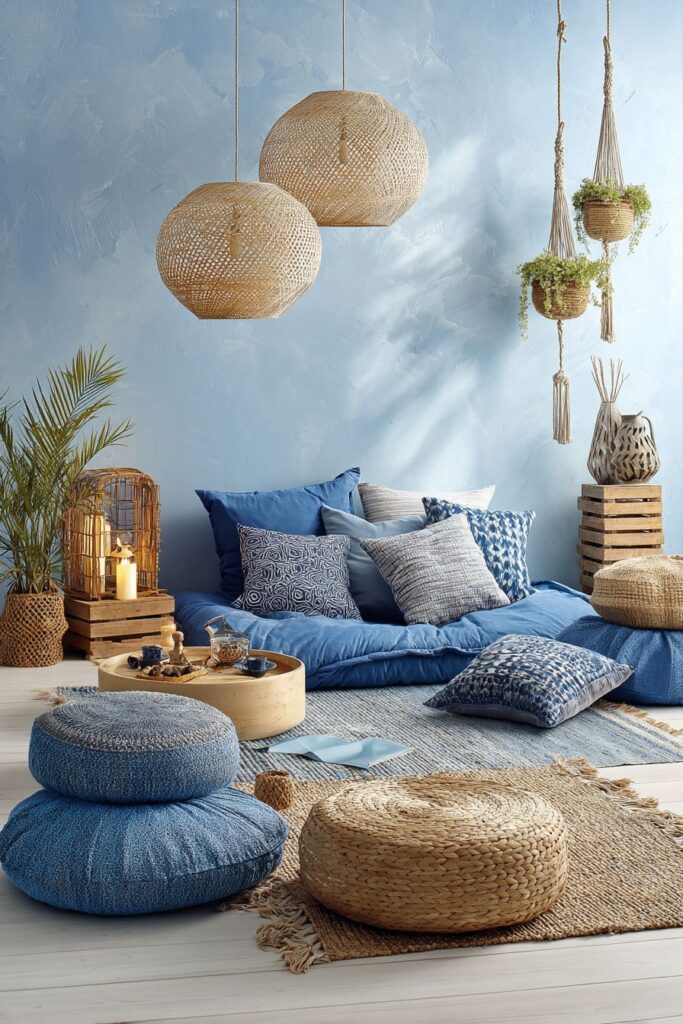
Oversized floor cushions in varied blue patterns surround the central sofa, creating flexible seating that can be rearranged for different group sizes and activities. Some cushions might feature block-printed Indian textiles, others Moroccan embroidery, and still others Japanese shibori dyeing, each bringing unique cultural perspective and artisan craftsmanship into the collected whole. This variety prevents monotony and celebrates the handmade and globally sourced.
Macramé wall hangings and hanging plants create essential vertical interest against powder blue walls, drawing the eye upward and adding organic, handcrafted texture to vertical surfaces. The natural fiber of the macramé relates to the floor cushions and layered rugs, creating textural cohesion even as colors and patterns vary widely. Hanging plants introduce living elements that purify air and add the ever-changing natural element so important to bohemian spaces.
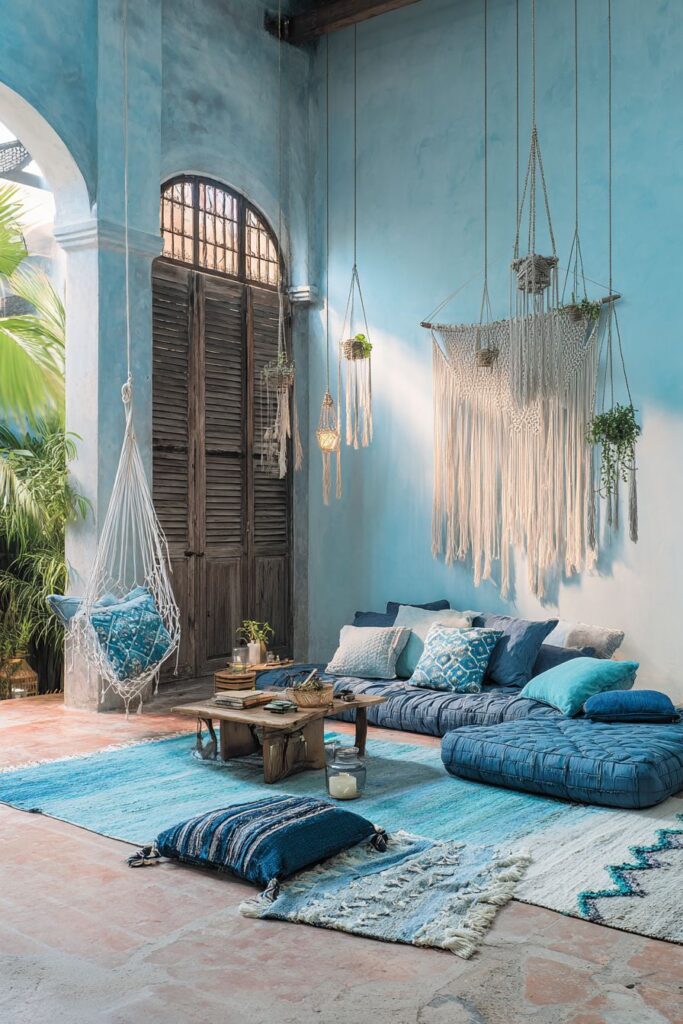
Layered vintage rugs in blues and earth tones define the relaxed seating area while providing essential cushioning for the low floor seating. This layering technique allows for mixing patterns, cultures, and ages of textiles in a way that feels intentional rather than haphazard. Natural daylight floods the space, emphasizing the casual, laid-back aesthetic and revealing the natural texture variations in the diverse blue textiles that make this room feel collected and authentic rather than decorated.
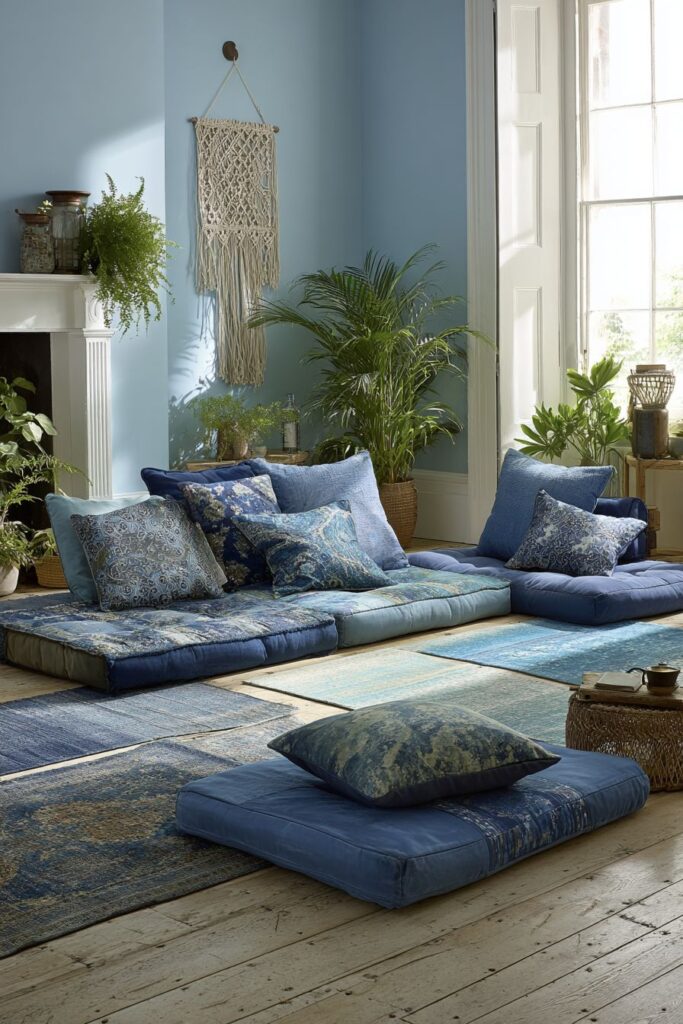
Key Design Tips:
- Embrace low-profile, floor-level seating for authentic bohemian casual comfort
- Mix globally sourced textiles from different cultures for genuine eclectic character
- Layer multiple rugs rather than using a single large rug for visual interest and flexibility
- Incorporate handmade elements like macramé, woven baskets, and artisan-crafted accessories
- Add abundant plants in hanging planters and floor pots to bring nature indoors
- Choose indigo and naturally dyed textiles over synthetic colors for authentic bohemian aesthetic
- Allow collections and treasures to accumulate over time rather than decorating all at once
- Create flexible seating arrangements that can adapt to different group sizes and activities
12. Entertainment Hub: Navy Blue Media Wall Design
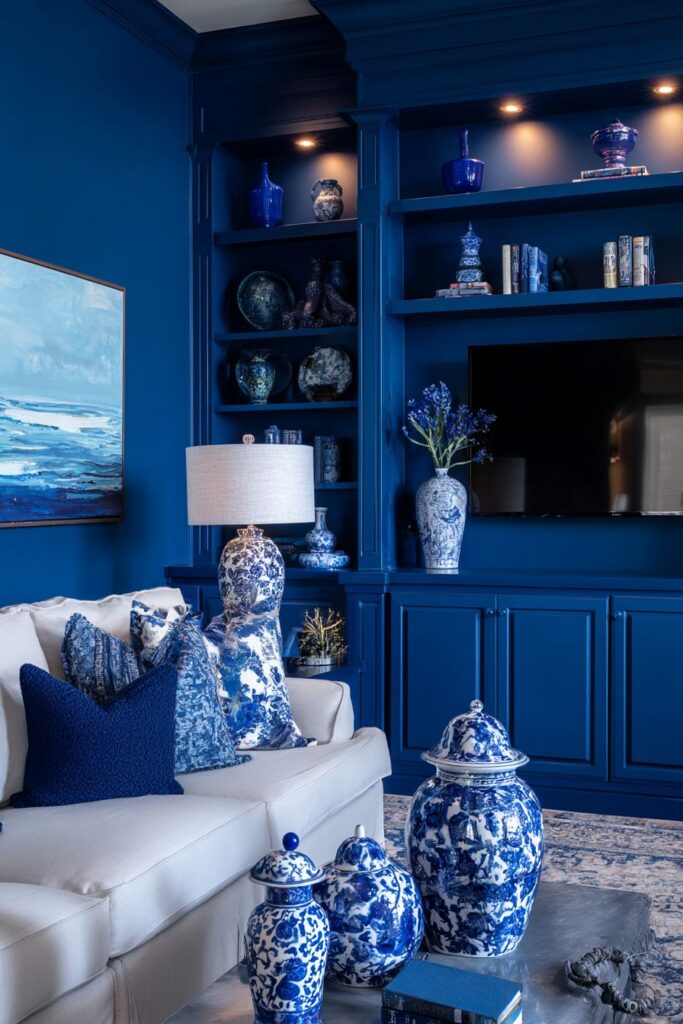
The modern living room must accommodate technology without sacrificing style, as perfectly demonstrated in this custom entertainment center design. A custom-built navy blue media wall featuring integrated shelving creates a sleek, architectural focal point that houses electronics, displays decorative objects, and provides essential storage. The deep navy finish lends sophistication and visual weight to what could otherwise be a purely utilitarian feature, transforming functional necessity into design statement.

Concealed cable management represents thoughtful planning that separates amateur from professional installations. By hiding the tangle of wires, power cords, and connections that modern entertainment systems require, the design maintains clean lines and visual calm. This attention to detail ensures that the eye focuses on the intentional design elements rather than being distracted by technical necessities.
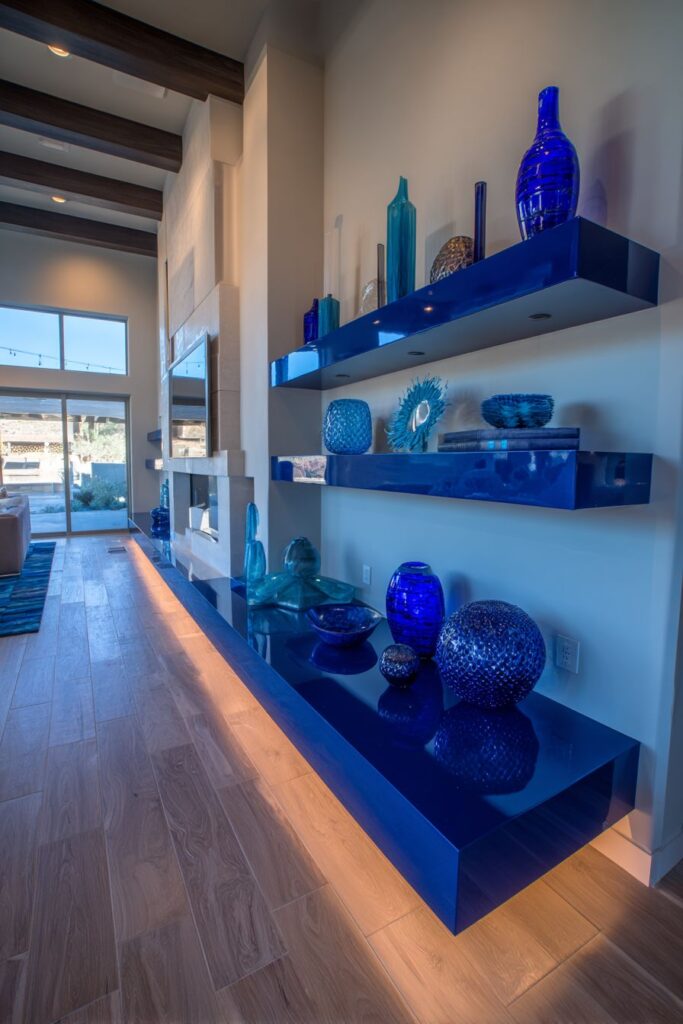
The floating TV mount centers the composition, creating a primary viewing focal point while maintaining the floating, contemporary aesthetic that defines modern built-in design. Open shelving flanking the television displays decorative objects in complementary blue tones, creating color cohesion while breaking up the expanse of cabinetry. These styled shelves might hold blue glass vases, ceramic sculptures, or books with blue spines, each contributing to the overall color story.
LED strip lighting integrated behind floating shelves and beneath cabinets highlights architectural elements while providing ambient lighting for evening viewing. This indirect lighting creates dramatic effect without glare, emphasizing the three-dimensional quality of the built-in unit and creating a sophisticated atmosphere perfect for movie nights or entertaining. The practical storage solutions, including closed cabinets for media equipment and gaming systems, maintain the sophisticated blue finish while keeping clutter contained and out of sight.
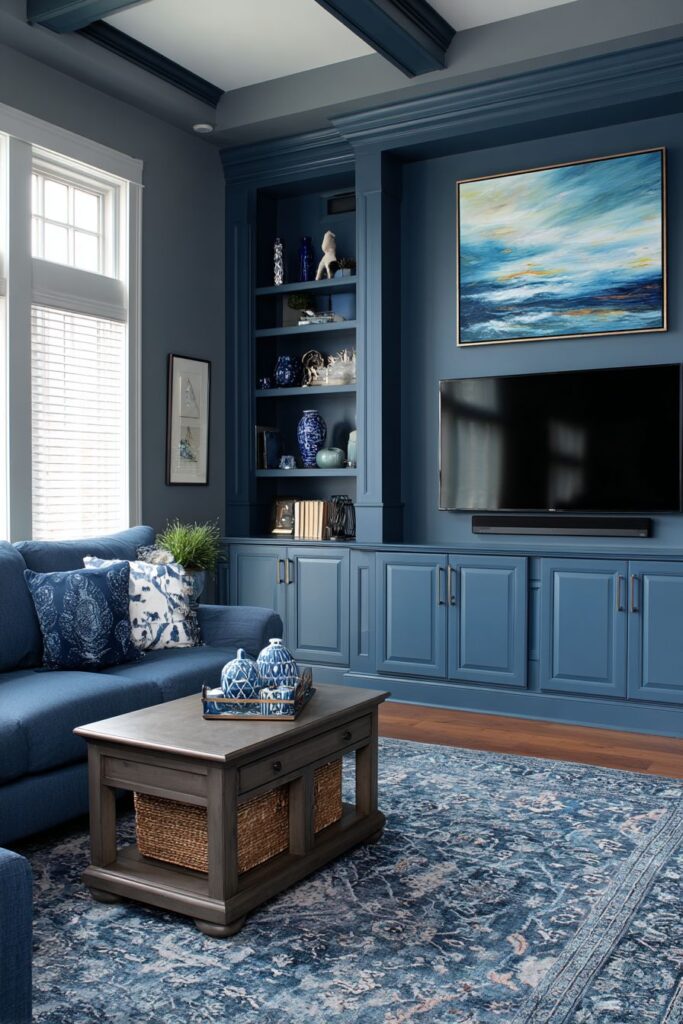
Key Design Tips:
- Design custom media walls with both open and closed storage for display and concealment balance
- Choose deep blue finishes for media walls to minimize screen glare and create sophisticated backdrop
- Invest in professional cable management during installation for clean, finished appearance
- Incorporate LED lighting behind shelves and beneath cabinets for dramatic ambient effect
- Select floating mounts for televisions to maintain contemporary streamlined aesthetic
- Style open shelving with objects in complementary blue tones for color cohesion
- Include adequate closed storage for gaming systems, media components, and accessories
- Consider acoustic properties when designing around entertainment equipment
13. Transitional Harmony: Steel Blue Balanced Design
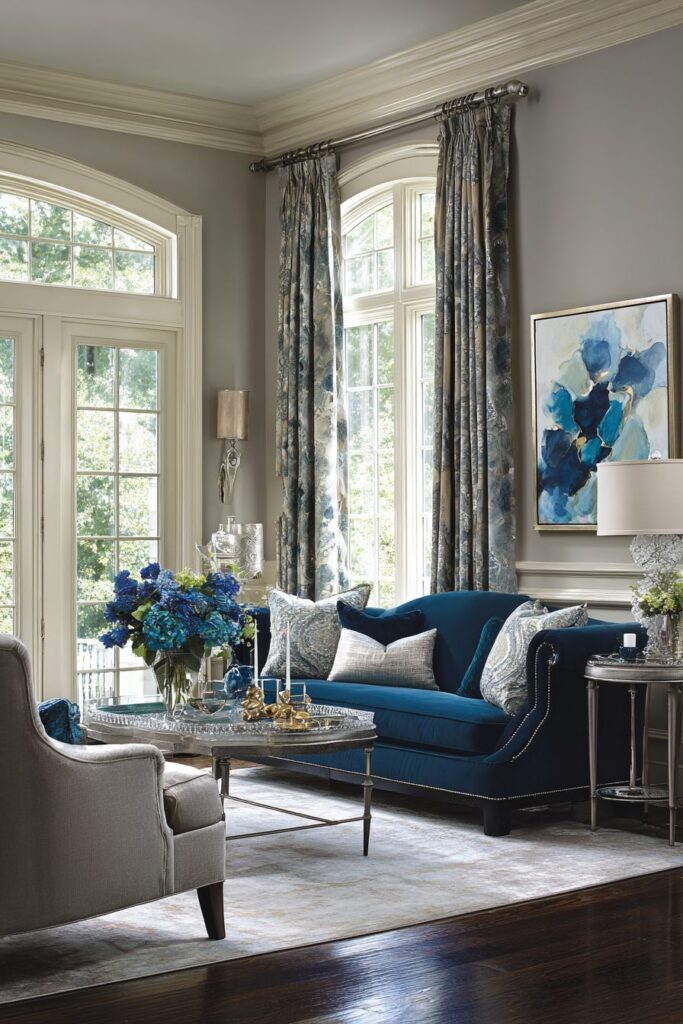
Transitional design bridges traditional and contemporary aesthetics, as beautifully illustrated in this harmonious blue living room. A steel blue sofa featuring classic rolled arms paired with modern metal legs embodies this style fusion, honoring traditional comfort and silhouettes while updating the look through contemporary materials and finishes. The muted steel blue color serves as the perfect neutral-toned blue, sophisticated enough for traditional spaces yet modern enough for contemporary settings.
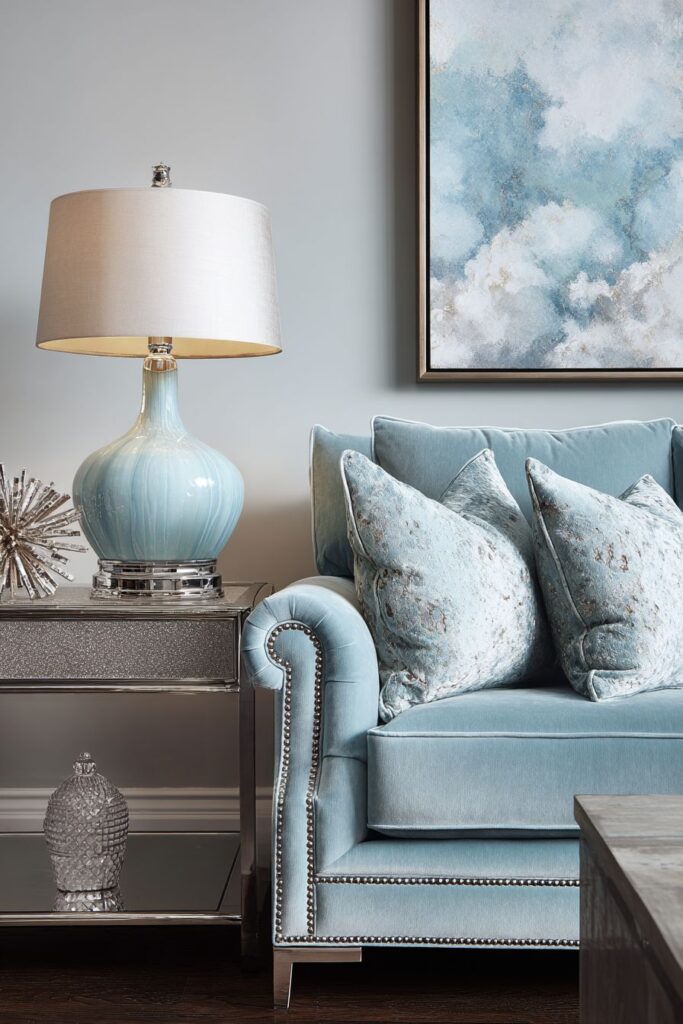
Walls in soft greyish-blue create a neutral backdrop that supports the transitional aesthetic, neither too warm and traditional nor too cool and contemporary. This carefully chosen wall color allows mixed design elements to coexist peacefully, providing a unifying envelope that ties together disparate pieces. The subtle blue tint prevents the grey from feeling cold while maintaining the understated elegance that transitional design requires.
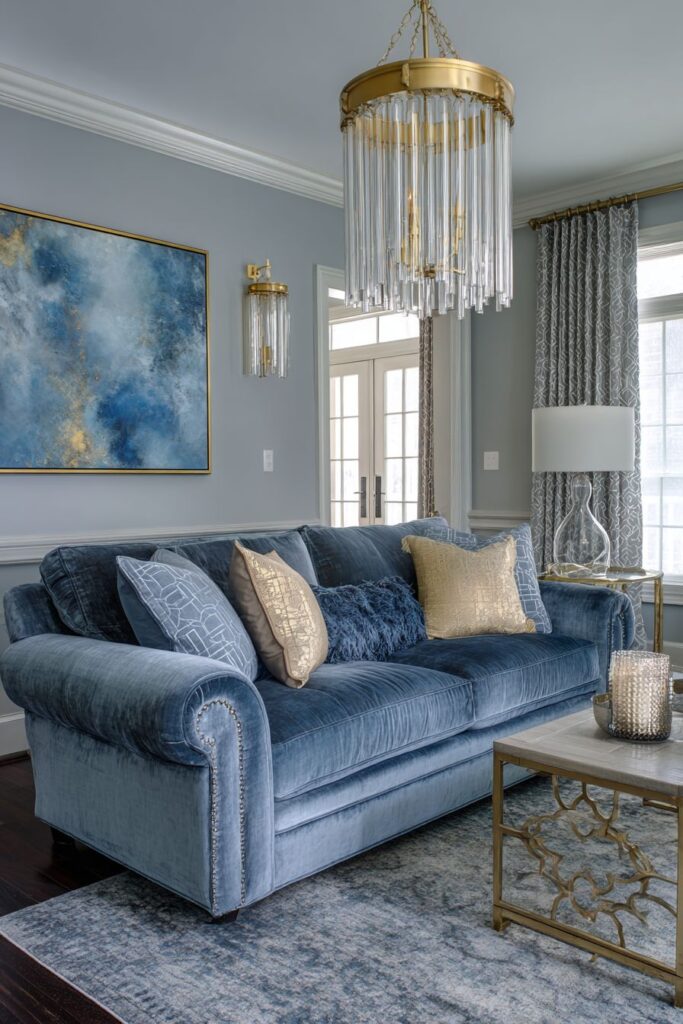
Mixed metal accents in brass and chrome throughout the space represent the transitional approach to finishes, where warming brass brings traditional richness while cooler chrome maintains contemporary edge. Table lamps might feature brass bases with chrome accents, or vice versa, while decorative accessories incorporate both finishes in a way that feels intentional rather than indecisive. This mixing prevents the space from feeling too matchy or coordinated, instead creating a collected-over-time appearance.
Abstract artwork incorporating blue color pops serves as the contemporary element that keeps this space from skewing too traditional. The abstracts provide visual interest and personality without introducing representational imagery that might date the space or overwhelm the carefully balanced design. Soft natural lighting floods through windows, captured and reflected by the mixed metals and illuminating the calming blue foundation that makes this room feel peaceful and inviting.
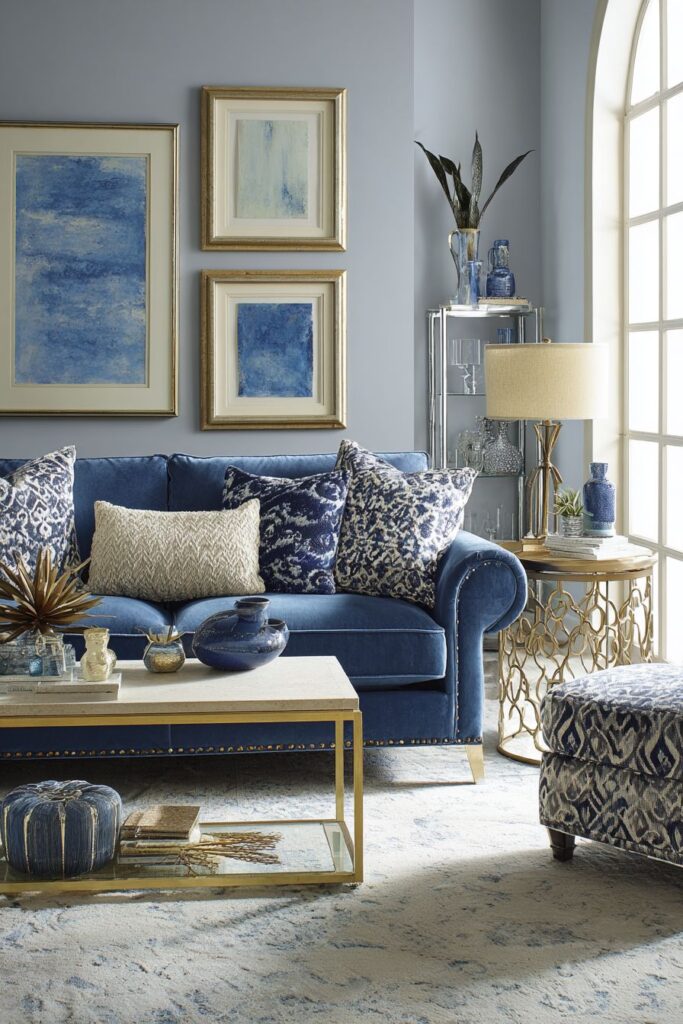
Key Design Tips:
- Select furniture that combines traditional silhouettes with contemporary materials or vice versa
- Choose muted blue tones that work across both traditional and contemporary aesthetics
- Mix metal finishes intentionally, combining warm brass with cool chrome or silver
- Incorporate both classic and contemporary lighting fixtures for balanced design approach
- Select abstract artwork that introduces color without strong stylistic declaration
- Use soft, greyish-blue wall colors that serve as sophisticated neutral backdrop
- Balance ornate and simple elements throughout the space for true transitional harmony
- Layer textures to add interest without relying on pattern or bold color contrasts
14. Ceiling Statement: Navy Above, Light Below
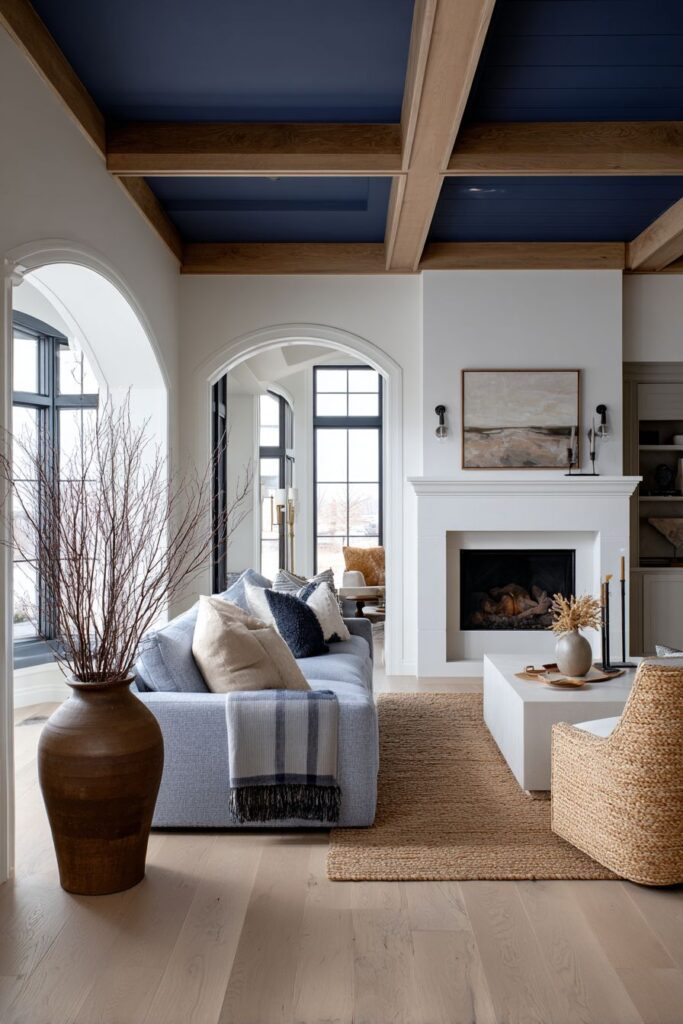
Bold design choices define memorable spaces, and this living room makes an unforgettable statement with a dramatic navy blue painted ceiling. This unexpected color placement contrasts beautifully with white walls and a lighter periwinkle blue sofa below, creating visual interest through inversion of expected color hierarchy. The dark ceiling draws the eye upward, emphasizing architectural details and creating a sense of intimacy and enclosure even in rooms with high ceilings.
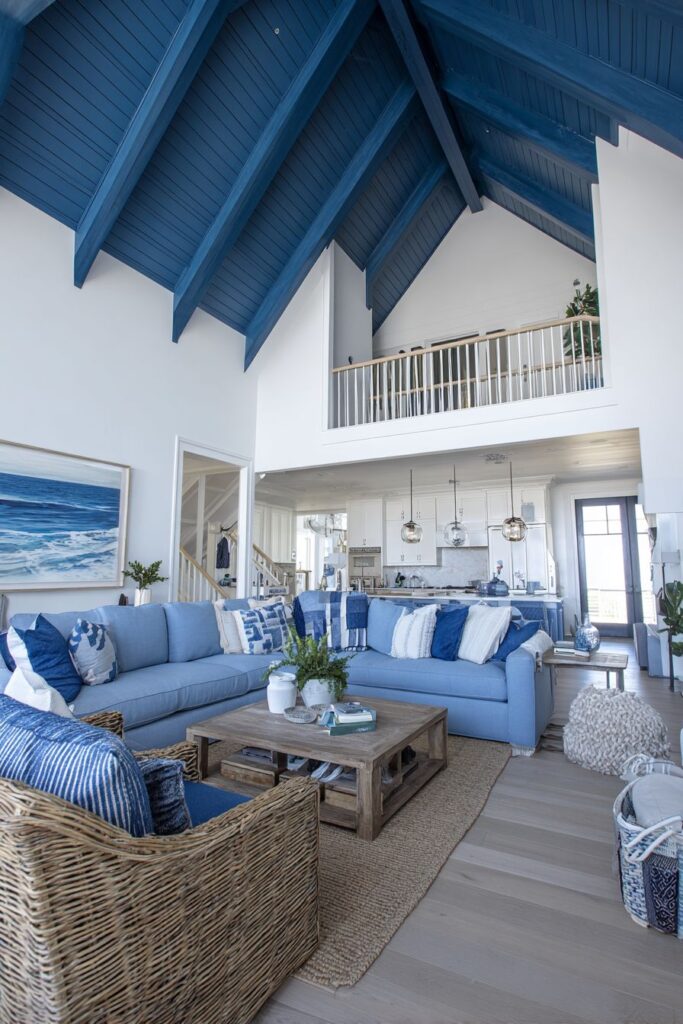
The navy ceiling creates drama without overwhelming the space because the lighter walls and furniture maintain overall brightness and prevent the room from feeling closed in or cave-like. This technique works particularly well in rooms with abundant natural light, where the ceiling color becomes an intentional design choice rather than a light-absorbing mistake. Architectural details like crown molding, ceiling medallions, or exposed beams receive special emphasis when painted in contrasting dark blue, highlighting features that might otherwise go unnoticed.

White oak flooring and natural fiber textures throughout the space balance the bold ceiling choice with organic, grounding elements. The warm, honey-toned wood prevents the cool blue ceiling from making the room feel cold, while natural textures in rugs, baskets, and window treatments add essential warmth and tactile interest. These natural elements create a connection to the outdoors and prevent the bold color choice from feeling artificial or overly designed.
Strategic lighting becomes crucial in this design, with recessed ceiling lights, table lamps, and floor lamps working together to ensure the dark ceiling doesn’t darken the entire space. The lighting plan must account for the light-absorbing properties of the navy ceiling while creating ambient glow that makes the unique design choice appear intentional and successful. Natural light interacts fascinatingly with the varied blue surfaces, creating different moods throughout the day as sun angles change.
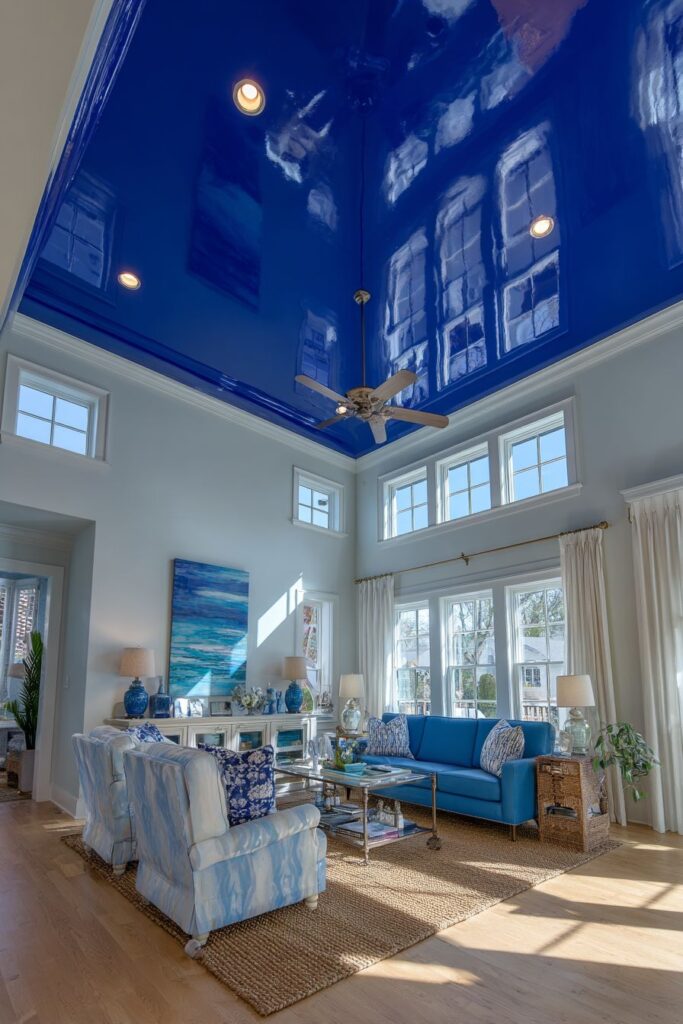
Key Design Tips:
- Test navy ceiling paint in your specific room before committing, as results vary with ceiling height and natural light
- Maintain bright walls and light-colored flooring to prevent dark ceilings from overwhelming the space
- Highlight architectural ceiling details through contrasting paint color
- Use lighter blue upholstery and accessories to create color cohesion without matching the ceiling exactly
- Install ample lighting, including recessed ceiling lights that illuminate the dark surface from within
- Choose warm wood flooring to balance cool ceiling tones
- Incorporate natural textures to ground the bold design choice with organic elements
- Consider ceiling height and natural light availability before attempting dramatic ceiling colors
15. Industrial Edge: Blue Leather Meets Exposed Brick
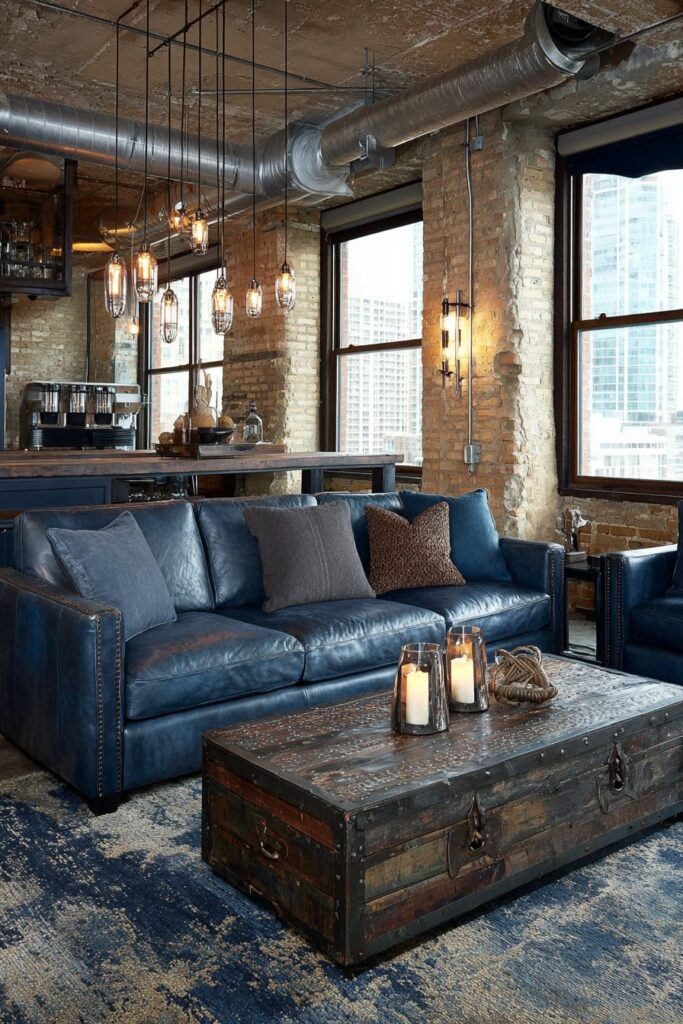
Urban sophistication and industrial aesthetics combine in this edgy blue living room where refined meets raw. A leather sofa in deep blue anchors the space, its rich color and genuine leather upholstery representing quality and permanence while introducing unexpected color into typically neutral industrial palettes. The leather’s natural grain and subtle sheen contrast beautifully with the rough, matte surfaces surrounding it, creating textural dialogue that defines this design approach.
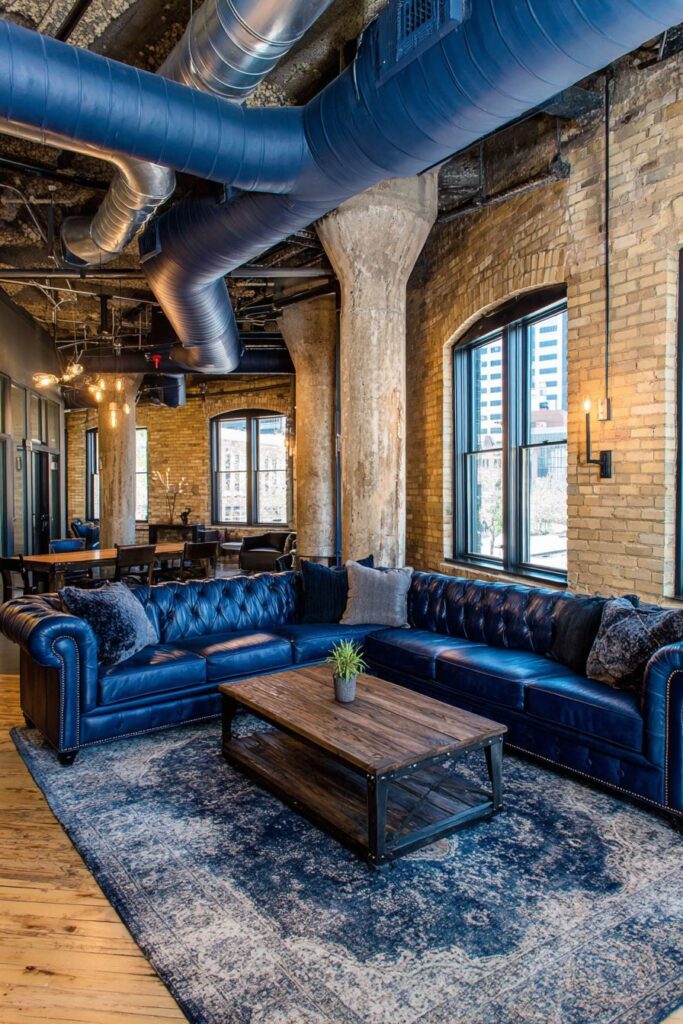
Exposed brick walls painted in muted blue-grey tones honor the industrial aesthetic while incorporating the room’s color theme. This technique maintains the textural interest of the brick while unifying the color palette, preventing the raw walls from competing with rather than complementing the furniture selections. The painted brick creates a sophisticated industrial look that feels considered and intentional rather than simply unfinished.
A metal and reclaimed wood coffee table centers the space, its mixed materials embodying the industrial design vocabulary. The metal might be raw steel with visible welds, or powder-coated iron in matte black, while the reclaimed wood top shows the character marks of previous use—nail holes, saw marks, and aged patina. Together these materials tell stories of industrial history and salvaged materials given new purpose.
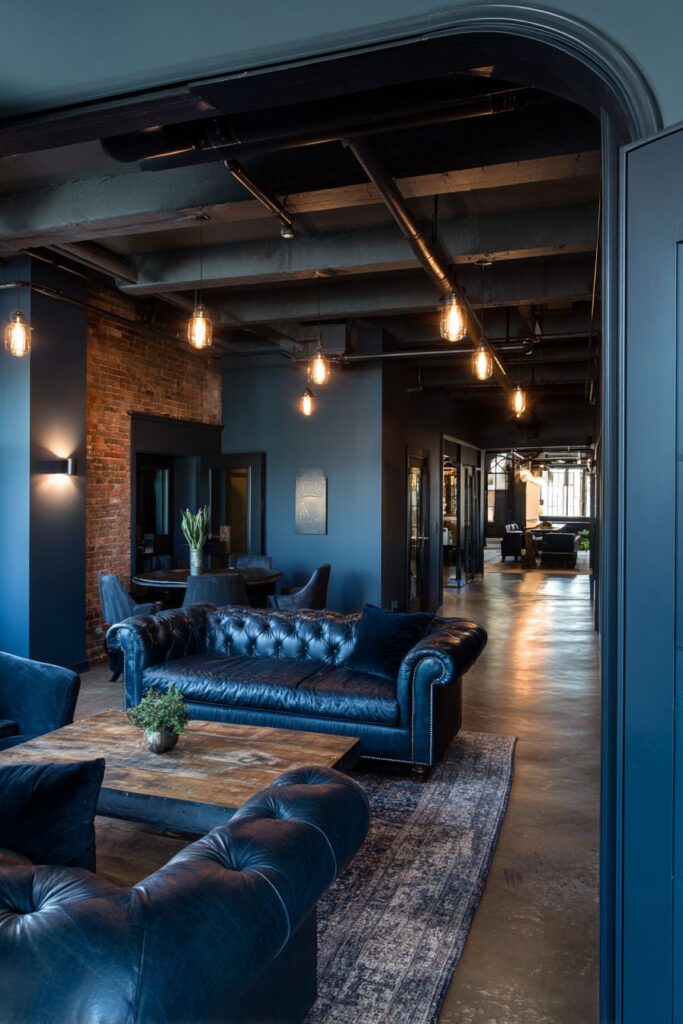
Edison bulb fixtures provide ambient lighting that reinforces the industrial aesthetic while creating warm, intimate glow. These exposed filament bulbs, whether hanging as pendants or incorporated into table lamps, celebrate the beauty of early electrical design while providing perfectly adequate modern illumination. The warm amber light they cast softens the urban edge and makes the deep blue leather appear rich and inviting rather than cold. Urban material authenticity defines this space, with every surface showing genuine character rather than manufactured distressing or fake industrial finishes. The distressed area rug beneath the seating arrangement shows real wear patterns, perhaps a vintage industrial carpet or a newer piece that’s genuinely aged rather than artificially distressed.
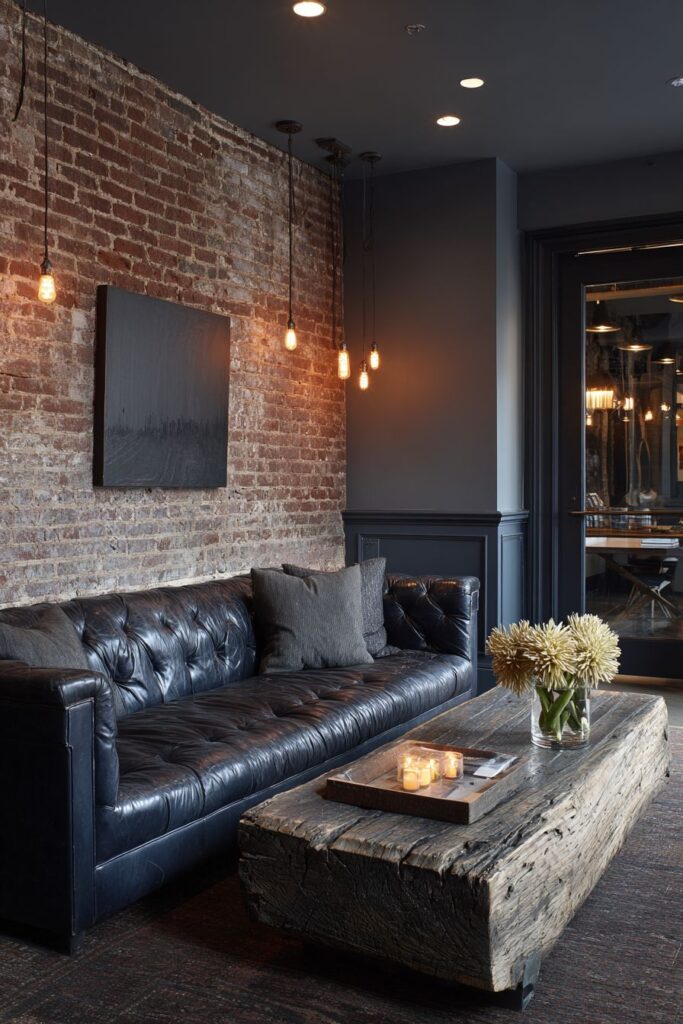
Key Design Tips:
- Choose genuine leather upholstery in deep blue for authentic material quality and long-term patina development
- Paint exposed brick in muted blue-grey tones rather than leaving it natural for color cohesion without sacrificing texture
- Select furniture with visible construction elements like welds, bolts, and raw metal edges
- Incorporate reclaimed wood pieces with authentic character marks and history
- Use Edison bulb lighting fixtures to reinforce industrial aesthetic while providing warm illumination
- Layer vintage or genuinely worn rugs rather than new pieces with artificial distressing
- Maintain exposed structural elements like ductwork, pipes, or beams when possible
- Balance raw industrial materials with refined upholstery to prevent the space from feeling unfinished
16. Dual Purpose Design: Navy Blue Workspace Integration
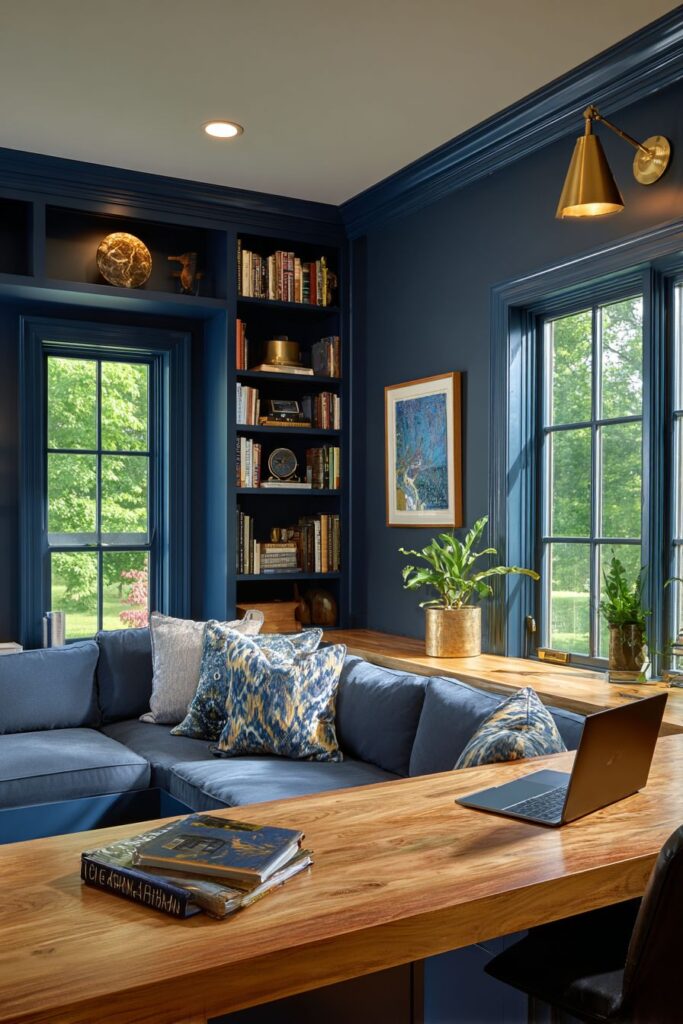
Modern living demands spaces that serve multiple functions, and this blue living room seamlessly incorporates a home office without sacrificing the room’s primary social purpose. A navy blue built-in desk and shelving system occupy one corner or wall section, creating a dedicated workspace that maintains visual connection to the rest of the room through consistent color application. The deep navy finish lends the workspace professional gravitas while distinguishing it from the casual living areas.

The main seating area includes a slate blue sofa positioned to maintain the room’s social function and conversation-friendly layout. The lighter slate blue creates visual separation from the darker workspace navy while maintaining overall color cohesion. This thoughtful color variation helps the eye distinguish between work and relaxation zones without requiring physical barriers or visual disruption.
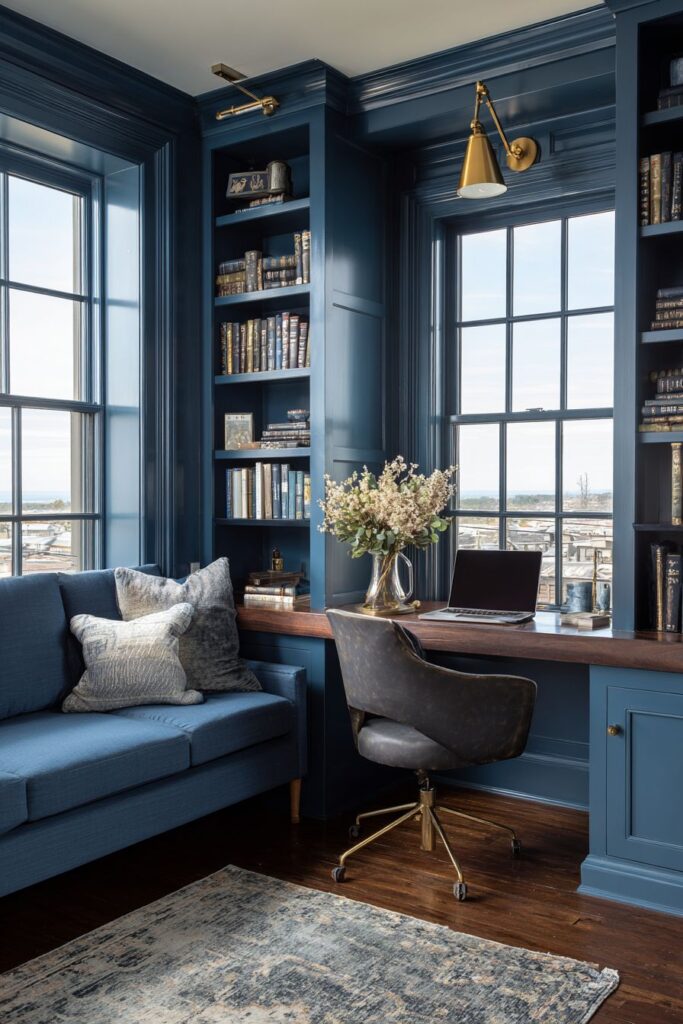
A natural wood desktop introduces essential warmth and organic beauty into the built-in workspace, its honey or walnut tones contrasting beautifully with the navy cabinetry while providing a practical, durable work surface. This wood element creates a visual bridge to other wood furniture in the living area, unifying the dual-purpose space through material repetition. Brass task lighting at the desk adds functional illumination for computer work and paperwork while introducing metallic warmth that elevates the design beyond purely utilitarian.
The genius of this layout lies in how the blue elements unify both functional zones while the furniture arrangement and scale variations create subtle separation. The built-in desk feels like architectural permanence rather than temporary office furniture, and its color coordination with the living room ensures it enhances rather than detracts from the overall design. This approach proves that home offices need not be hidden away or visually apologized for but can be celebrated as sophisticated, integrated elements of contemporary living.
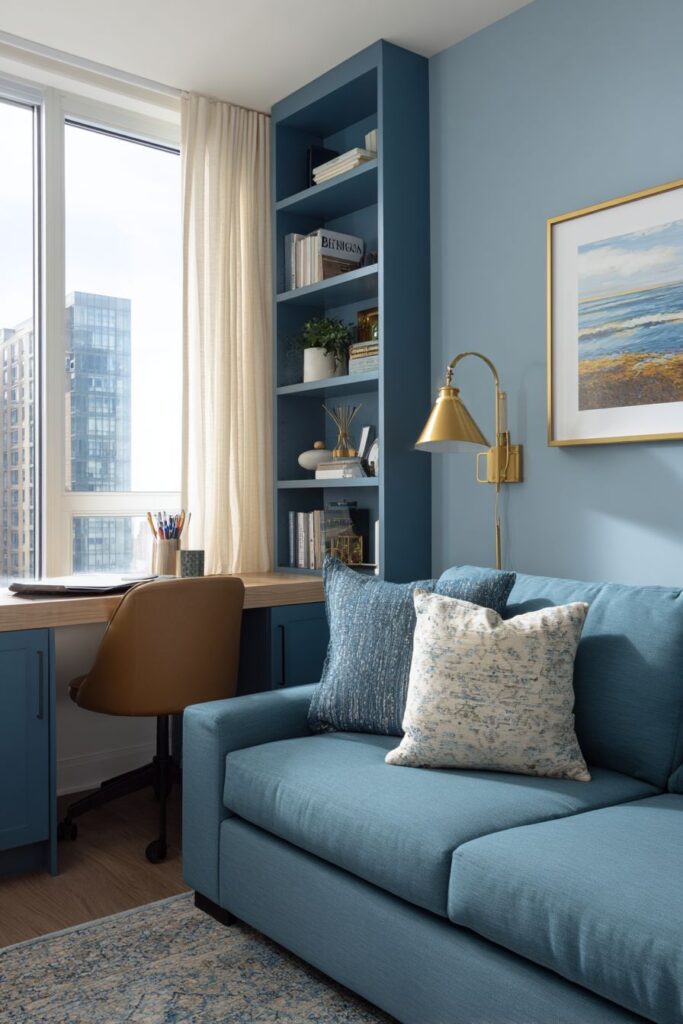
Key Design Tips:
- Design built-in workspaces in colors that coordinate with your living room for visual integration
- Use color variation within the blue family to subtly distinguish work and relaxation zones
- Incorporate natural wood desk surfaces for warmth and organic contrast with painted cabinetry
- Position the sofa to maintain conversation areas separate from workspace sight lines
- Install dedicated task lighting at the workspace for functional illumination
- Include adequate closed storage in built-ins to conceal work materials when not in use
- Choose desk chairs that coordinate with the room’s overall design rather than typical office seating
- Consider cable management and technology needs during the design phase for clean integration
17. Modular Modern: Cerulean Blue Flexible Living
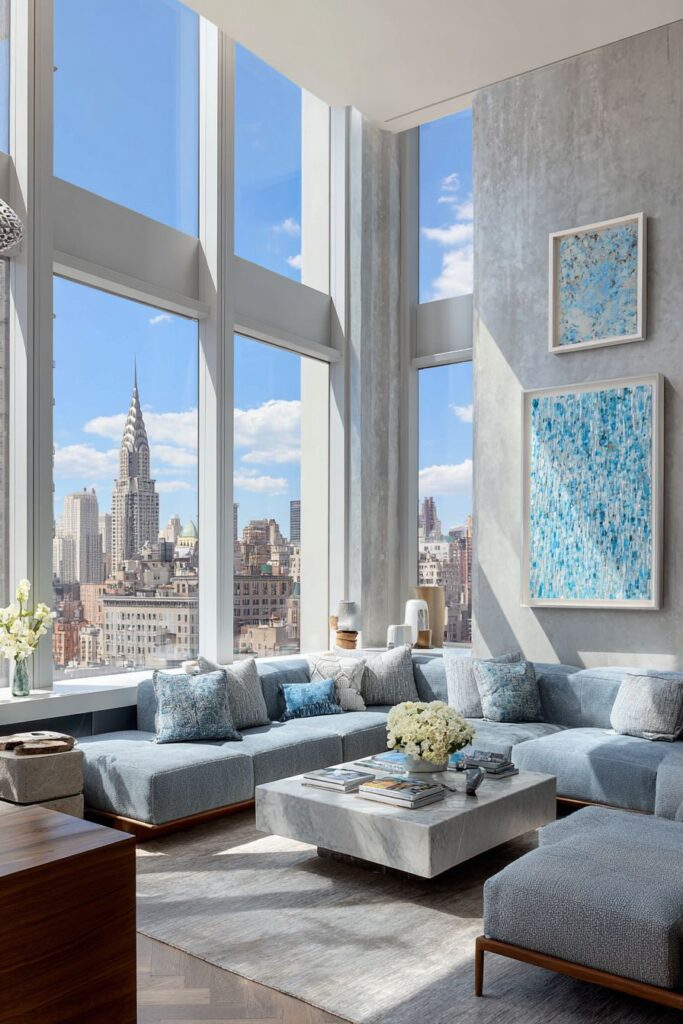
Contemporary living demands flexibility, and this modern blue living room delivers through its intelligent use of modular furniture. A modular cerulean blue sectional sofa that can be rearranged for different occasions represents the ultimate in adaptable design, allowing the room to transform from intimate conversation area to party-friendly mingling space to movie-watching theater configuration. The bright, clear cerulean blue brings energy and optimism to the space while maintaining the sophistication expected in contemporary design.
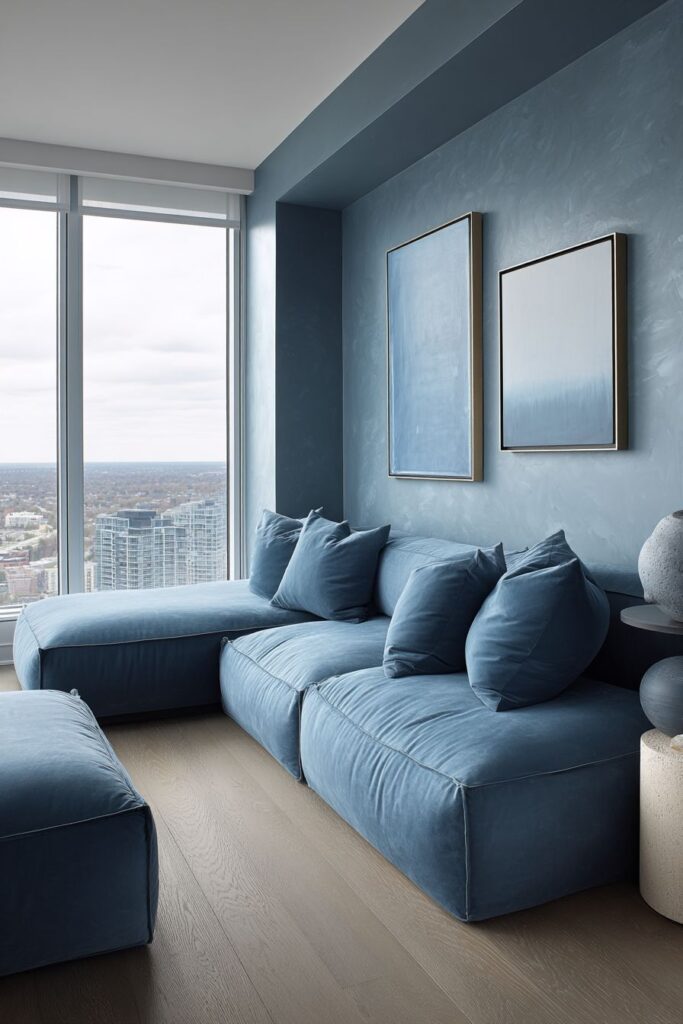
Walls feature textured blue-grey plaster with subtle variations that create depth and visual interest without pattern or decorative complexity. This sophisticated wall treatment elevates the space beyond standard paint, introducing artisanal quality and dimensional texture that rewards close inspection. The blue-grey tones create a tonal relationship with the cerulean upholstery while remaining neutral enough to serve as backdrop rather than competing for attention.
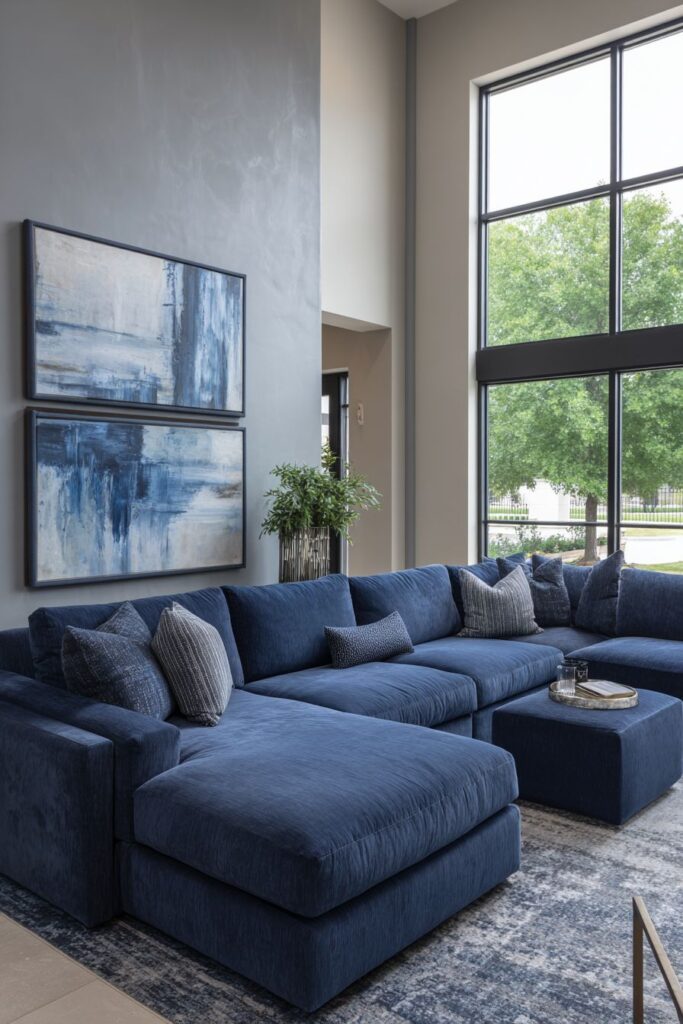
Abstract sculptures and modern artwork in blue tones create visual interest and cultural sophistication throughout the space. These art pieces might range from small ceramic sculptures on shelving to large-scale canvas paintings commanding wall space, each contributing to the room’s contemporary aesthetic. The monochromatic blue color story allows diverse art pieces to coexist harmoniously while maintaining visual cohesion.
Floor-to-ceiling windows flood the space with natural light, essential for showcasing the sophisticated monochromatic blue palette and preventing it from feeling heavy or monotonous. The abundant natural light creates ever-changing shadows and highlights throughout the day, revealing the textural quality of the plaster walls and the dimensional nature of the blue upholstery. Professional balanced exposure in photography would capture both the bright window areas and the deeper blue tones without losing detail in either, demonstrating the room’s successful light management.
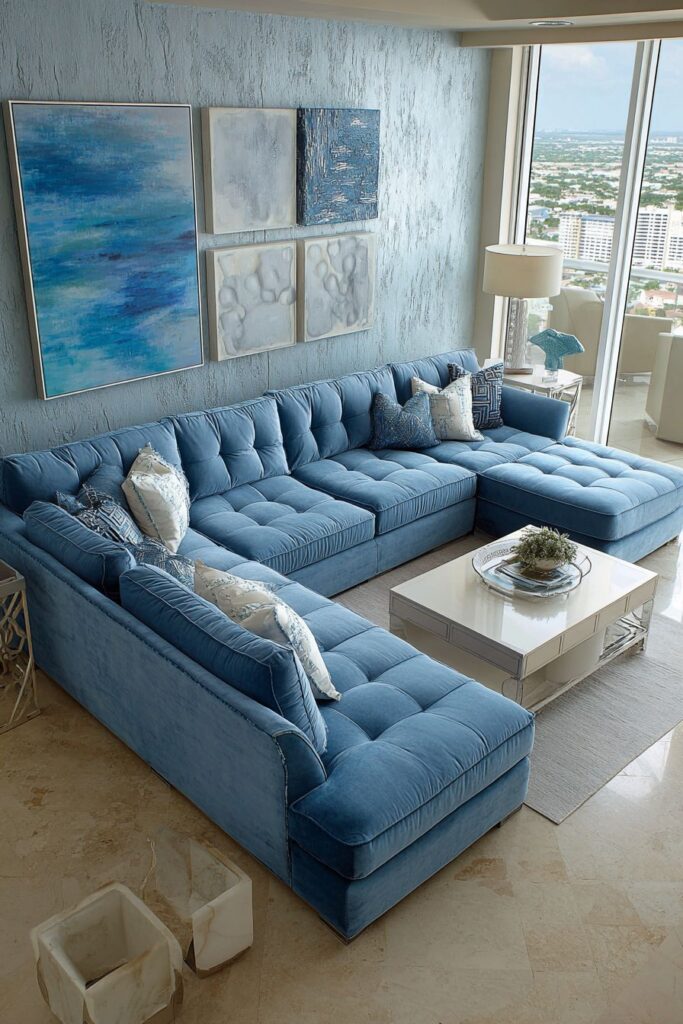
Key Design Tips:
- Invest in quality modular furniture that offers genuine rearrangement options for lifestyle flexibility
- Choose vibrant blue tones like cerulean for energy and contemporary appeal
- Consider textured wall treatments like Venetian plaster or textured paint for dimensional interest
- Incorporate abstract art and sculptures that complement without introducing competing colors
- Maximize natural light through large windows with minimal or no window treatments
- Create monochromatic color schemes using multiple shades and textures of the same color family
- Select furniture with hidden connection systems that allow reconfiguration without visible hardware
- Design for multiple room configurations by keeping furniture appropriately scaled and mobile
18. Fireplace Focus: Deep Navy Built-In Cabinetry

The fireplace traditionally serves as a living room’s natural focal point, and this design enhances that role through stunning custom cabinetry. Custom-built cabinetry in deep navy blue flanks a modern linear gas fireplace, creating an architectural focal point that commands attention while providing essential storage and display space. The deep navy finish brings drama and sophistication, transforming functional storage into a design statement that elevates the entire room.
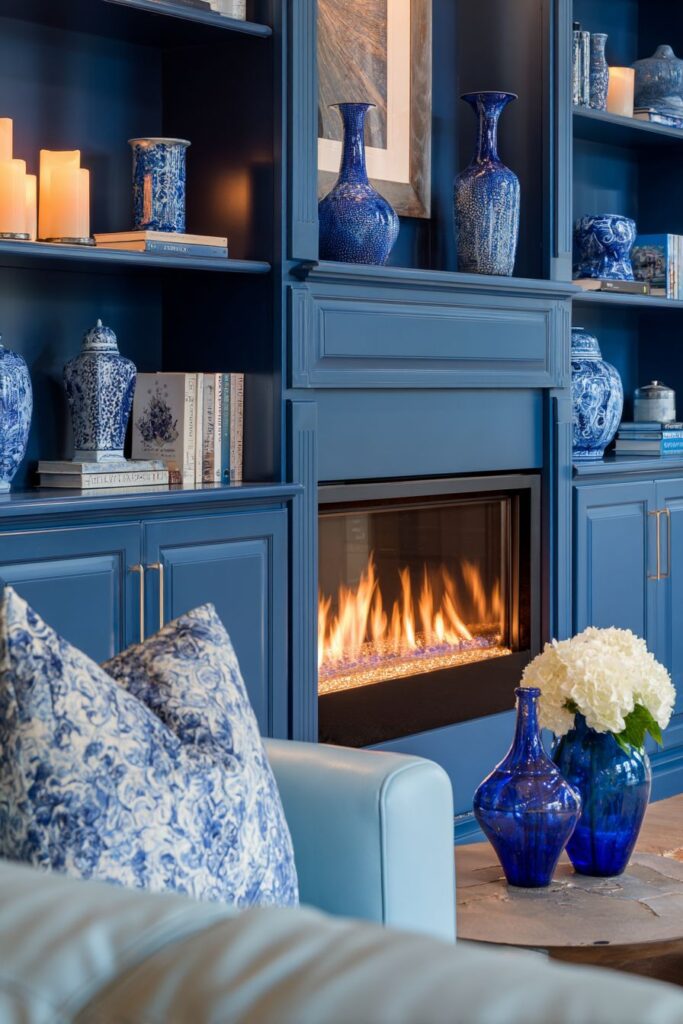
Open shelving integrated into the built-ins displays books and blue ceramic objects in a carefully styled arrangement that balances accessibility with aesthetic appeal. The open sections break up the expanse of closed cabinetry, preventing the wall from feeling heavy or oppressive while providing opportunity for personal expression through displayed collections. Blue ceramic pieces, ranging from pale sky to deep cobalt, create color cohesion while introducing varied forms and textures.
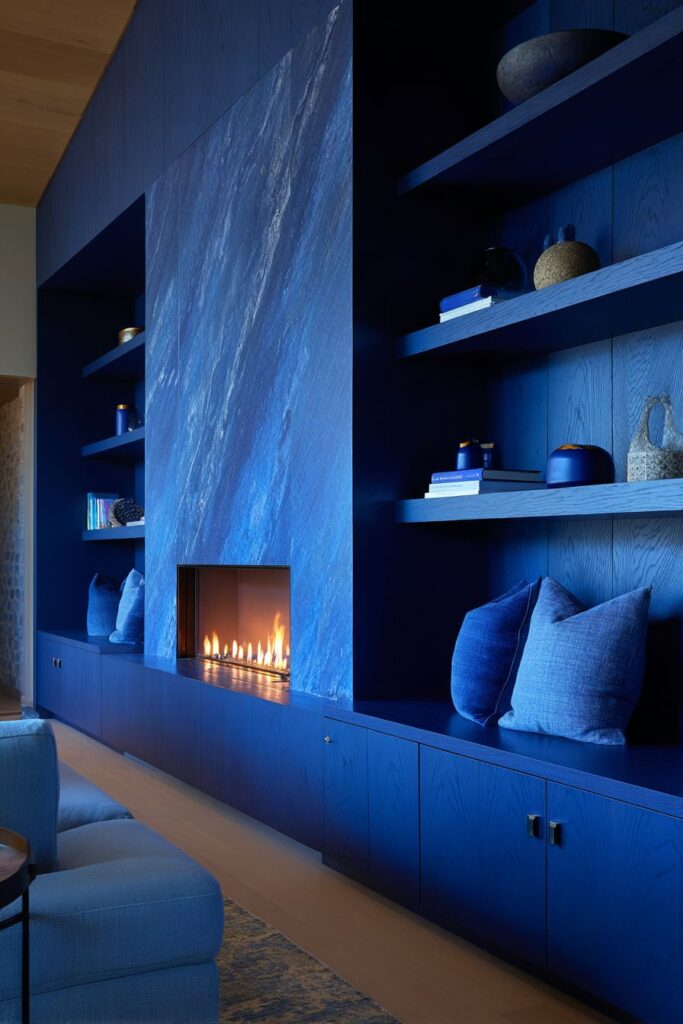
Closed storage in the lower cabinets maintains clean lines while concealing media equipment, board games, extra throw blankets, and the accumulated miscellany of daily life. This combination of open and closed storage represents thoughtful design that balances display and concealment, allowing the beautiful to be seen while hiding the utilitarian. The modern linear gas fireplace itself provides a horizontal visual element that grounds the tall vertical cabinetry, its clean lines and contemporary flames updating the traditional fireplace concept for modern living.
The adjacent seating area includes a light blue sofa positioned to enjoy the fireplace, creating a cozy conversation zone that takes advantage of both the visual interest and physical warmth the fireplace provides. Interior photography capturing this architectural focal point would emphasize the beautiful wood grain texture visible through the deep navy stain or paint, revealing quality craftsmanship while the firelight adds warm, flickering glow that makes the blue appear rich and inviting rather than cold.

Key Design Tips:
- Design fireplace surrounds with built-in cabinetry to maximize both storage and architectural impact
- Choose deep navy or dark blue finishes for dramatic effect and sophisticated ambiance
- Balance open display shelving with closed storage for functional versatility
- Select modern linear fireplaces for contemporary spaces or traditional mantels for classic rooms
- Style open shelving with objects in complementary blue tones for color cohesion
- Position primary seating to face or angle toward the fireplace for optimal enjoyment
- Use high-quality wood or custom cabinetry that will showcase grain and craftsmanship
- Incorporate lighting within built-ins to highlight displayed objects and create ambiance
19. Mediterranean Magic: Cobalt Blue Coastal European
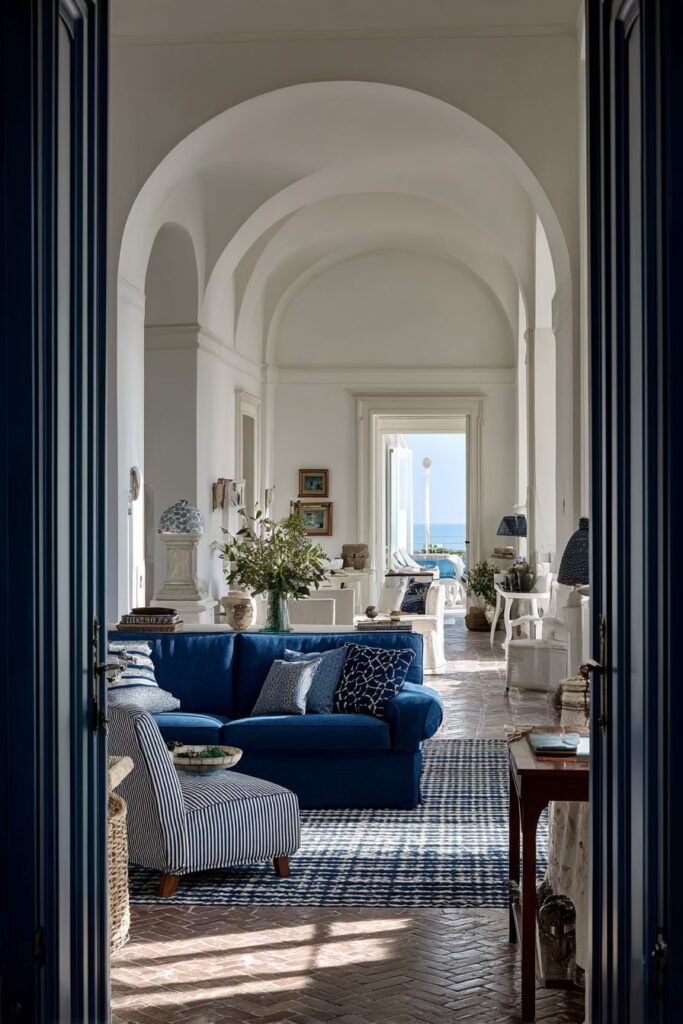
Sun-drenched Mediterranean style comes alive in this vibrant blue living room inspired by coastal European aesthetics. Whitewashed walls create the perfect backdrop for a vibrant cobalt blue sofa that serves as the room’s color anchor and energy source. The intense, saturated blue evokes the color of the Mediterranean Sea on brilliant sunny days, bringing vacation-like joy and relaxation into everyday living. Against the soft, textured white walls, this bold blue becomes even more striking, creating the kind of dramatic color contrast characteristic of Greek island architecture.
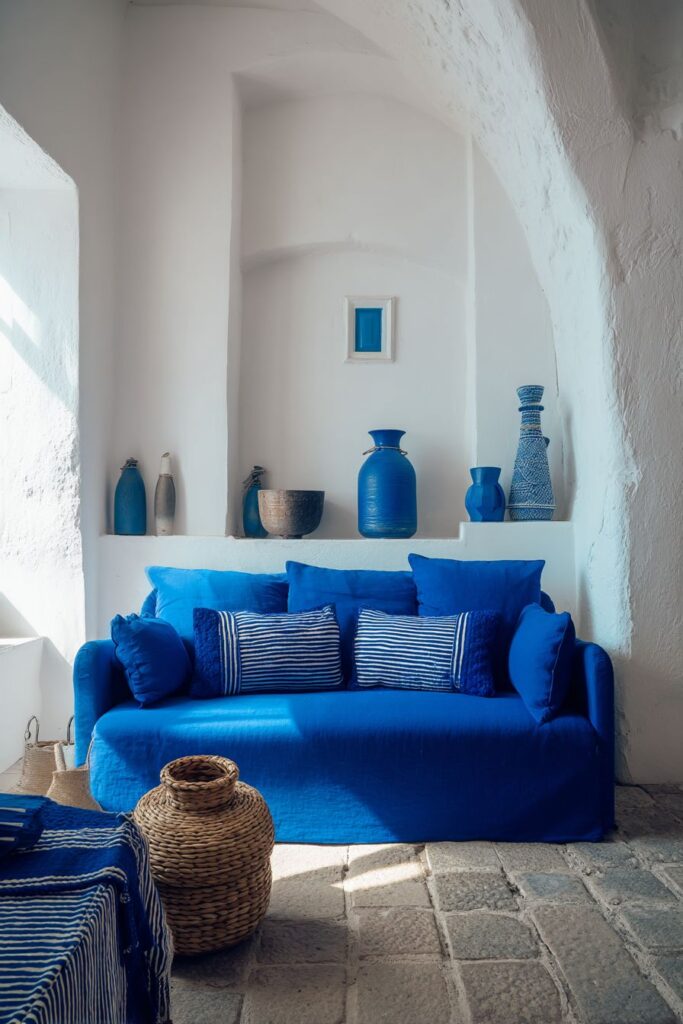
Terracotta tile flooring provides essential warmth and authentic Mediterranean character, its earthy red-orange tones creating beautiful color harmony with the cool cobalt blue. The tiles might be handmade with slight variations in color and texture, adding to the authentic, old-world feeling that defines Mediterranean design. Arched doorways provide architectural character that immediately signals Mediterranean influence, their curves softening the space and creating visual interest beyond furniture and decoration alone.
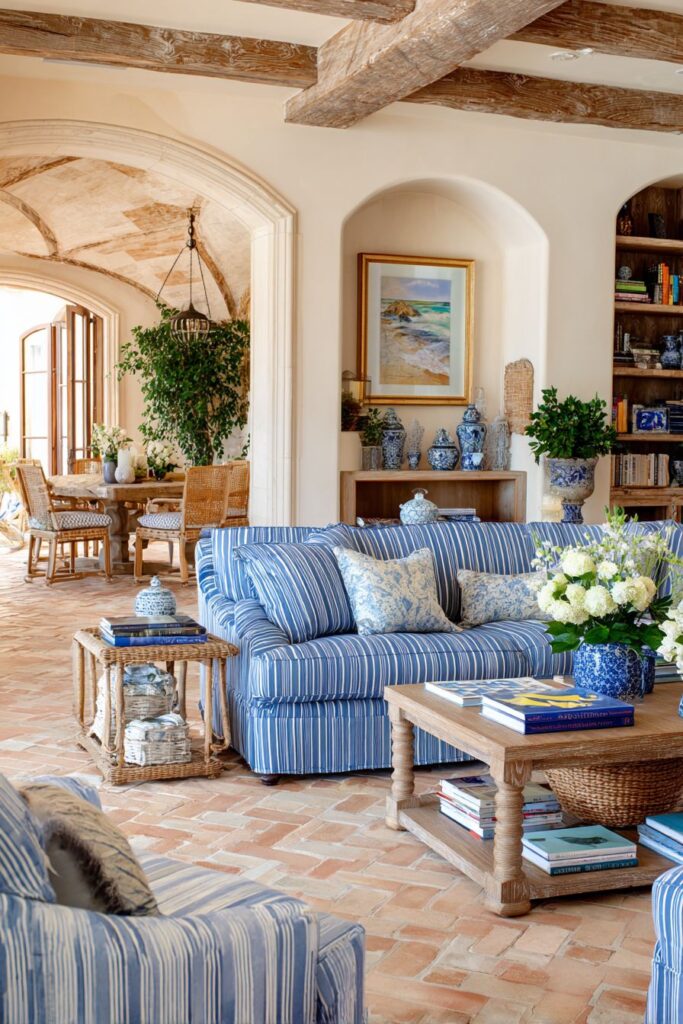
Woven blue and white striped textiles appear throughout the space in throw pillows, curtains, or table runners, their nautical-inspired pattern reinforcing the coastal theme while introducing pattern that complements rather than competes with the solid blue upholstery. Ceramic accents in traditional blue and white Mediterranean patterns, perhaps displayed on open shelving or as decorative plates mounted on walls, enhance the coastal European aesthetic while celebrating artisan pottery traditions.
Natural daylight floods the space, essential for achieving the sun-drenched atmosphere that defines Mediterranean living. The abundant light makes the white walls appear to glow while intensifying the cobalt blue upholstery, creating the kind of brilliant color saturation seen in Mediterranean vacation photographs. This is a space designed for brightness and joy, where the blue serves not as a calming neutral but as an energizing statement of color confidence.
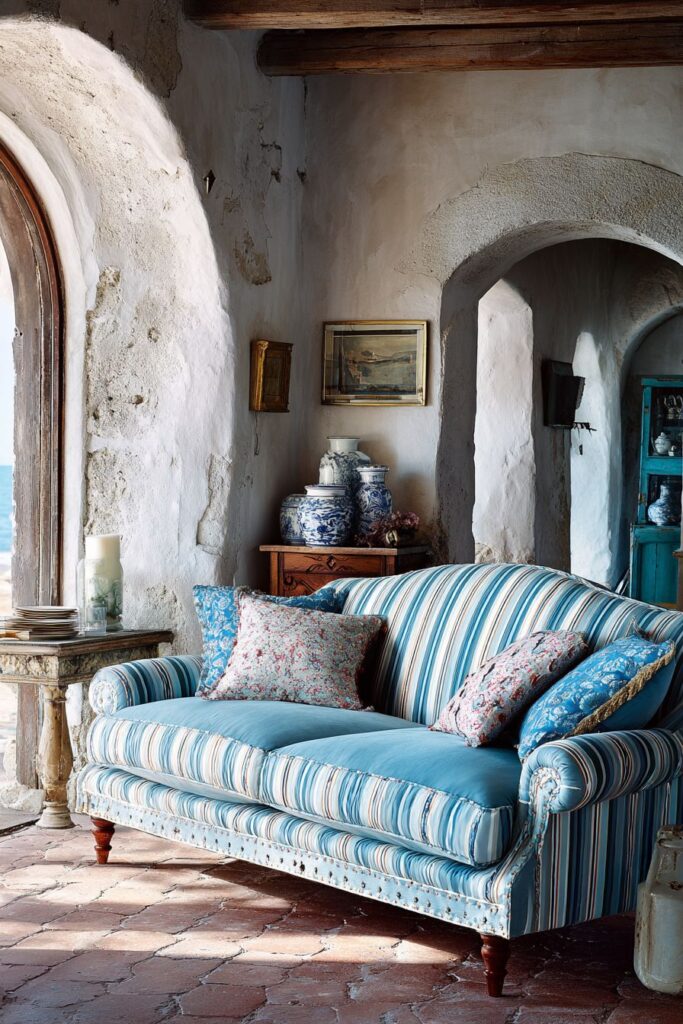
Key Design Tips:
- Choose vibrant cobalt or royal blue upholstery for authentic Mediterranean color intensity
- Whitewash walls or use bright white paint to create sun-drenched backdrop
- Install terracotta tile flooring for warm contrast and authentic Mediterranean character
- Incorporate architectural elements like arched doorways or windows when possible
- Add blue and white striped textiles for classic nautical-Mediterranean pattern
- Display traditional ceramic pieces in blue and white Mediterranean patterns
- Maximize natural light through large windows with minimal window treatments
- Balance the intense blue with plenty of white and warm earth tones to prevent overwhelming
20. Conversation Circle: Multi-Blue Armchair Arrangement
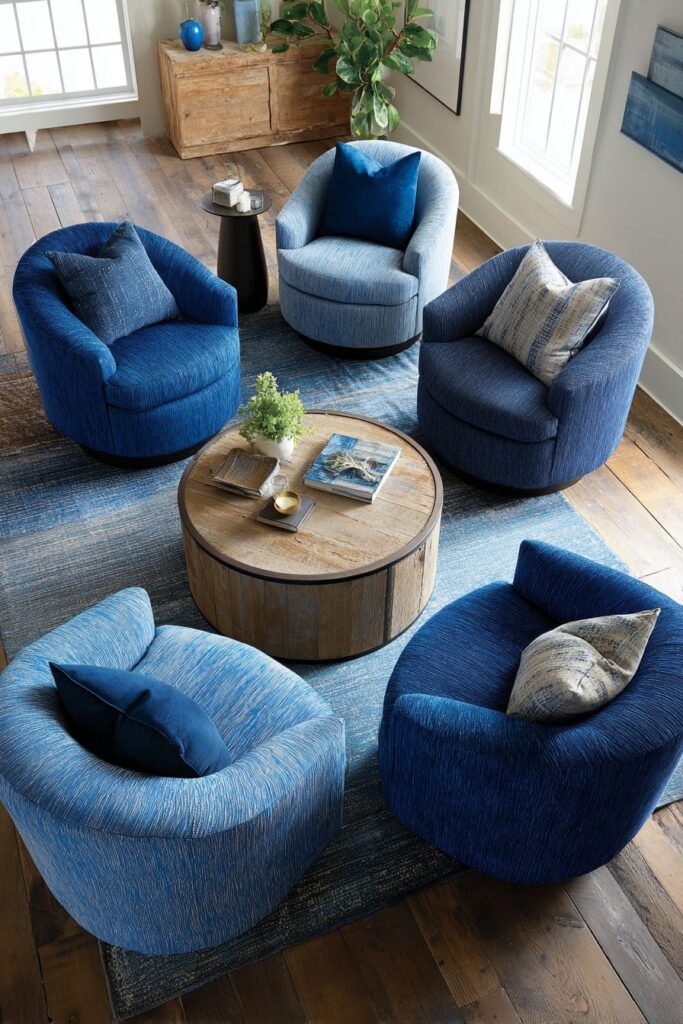
Thoughtful furniture arrangement can transform how people interact in a space, as demonstrated by this innovative conversation area. Four blue upholstered armchairs in varying shades from sky to navy arrange around a central round coffee table, creating a democratic seating arrangement where no seat dominates and everyone faces into the circle. This intentional layout encourages genuine conversation and eye contact, breaking from the typical sofa-and-chairs arrangement that can feel formal or create conversational blind spots.

The circular furniture arrangement harnesses psychological principles of equality and openness, making it ideal for book clubs, therapy practices, consulting offices, or simply homes where meaningful conversation is valued. Each chair’s unique blue hue, ranging from pale sky blue through medium cerulean to deep navy, creates visual interest and allows guests to select seating based on color preference while maintaining overall design cohesion through the shared blue family.
A subtle blue-toned area rug defines the space and unifies the varied chair colors, its muted tone preventing it from competing with the chairs while providing essential visual grounding. The rug’s circular or octagonal shape would reinforce the circular furniture arrangement, creating geometric harmony that strengthens the intentional layout. Neutral walls and warm wood accents prevent visual overwhelm that could occur with so much varied blue upholstery, instead allowing the chairs to be appreciated individually and as a collected group.
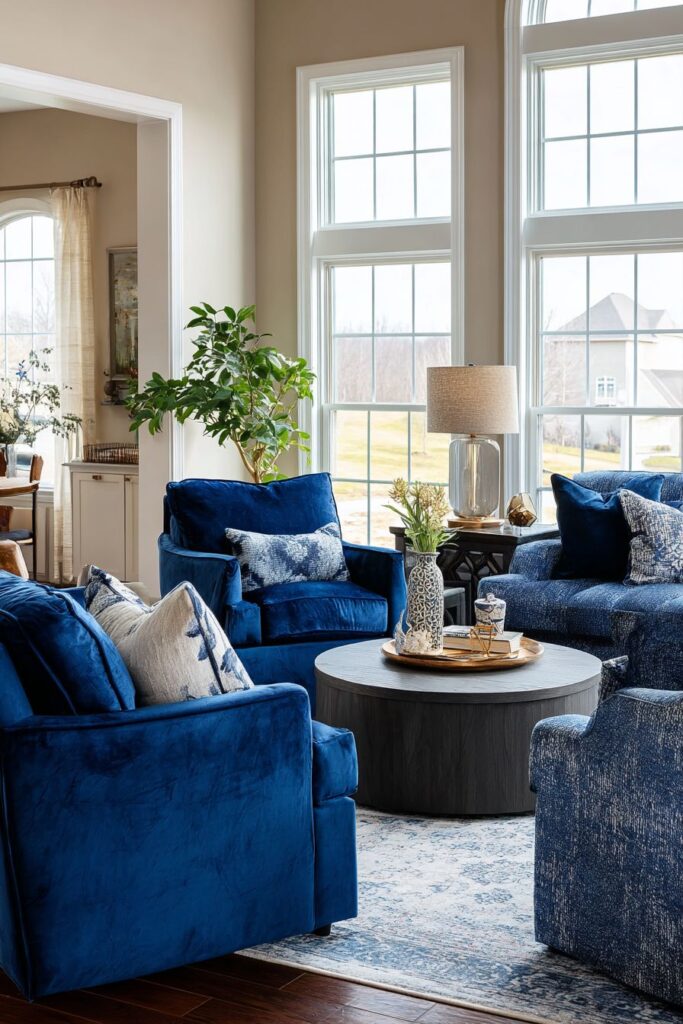
Wide-angle interior design photography would capture this intentional seating layout beautifully, showing how the circular arrangement creates intimate scale within a larger room. Soft natural lighting highlights each chair’s unique blue hue and fabric texture, revealing how different materials, from velvet to linen to leather, can all work within a single color family. This design proves that blue living rooms need not revolve around a single sofa, but can instead celebrate versatility and intentional social design.
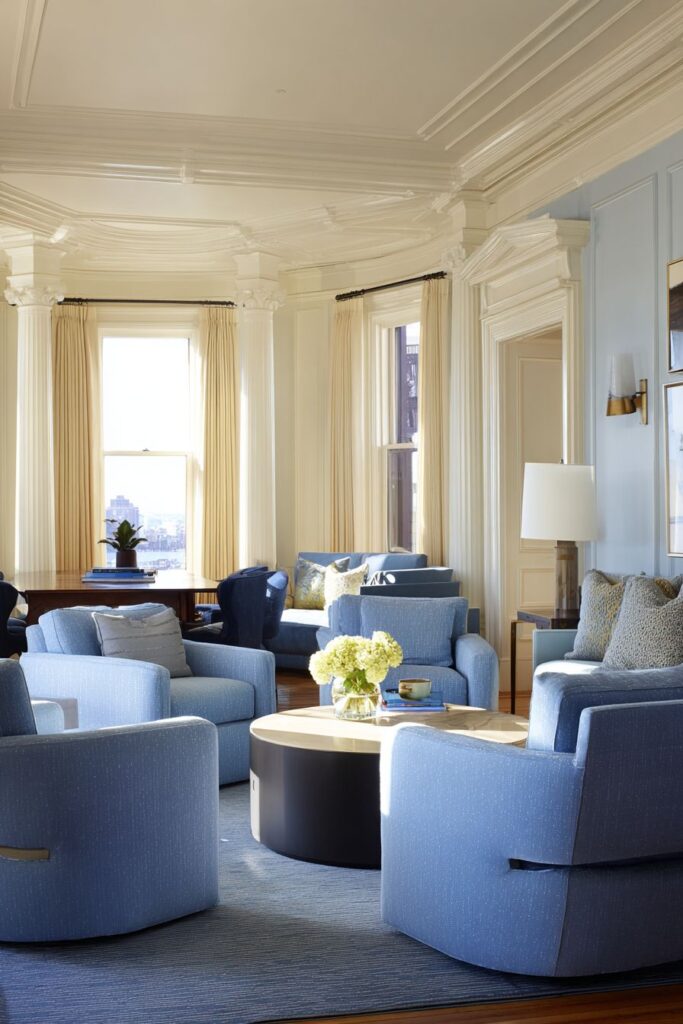
Key Design Tips:
- Arrange seating in circular or semi-circular patterns to encourage conversation and eye contact
- Select chairs in varying shades of the same color family for cohesion with visual interest
- Choose a round or octagonal coffee table to reinforce circular arrangement
- Vary fabric textures across chairs to create tactile diversity while maintaining color unity
- Use neutral wall colors to allow multi-colored seating to shine without competition
- Define the conversation area with an area rug that echoes the furniture arrangement shape
- Include warm wood accents to balance cool blue tones and prevent coldness
- Ensure adequate space between chairs for comfortable traffic flow and leg room
Why These Blue Living Room Designs Are the Best
These twenty blue living room designs represent the pinnacle of contemporary interior design thinking, each offering unique solutions to the challenge of creating beautiful, functional, and emotionally resonant living spaces. The versatility of blue as a color choice cannot be overstated—from the deepest navy to the palest powder blue, this color family offers unprecedented range for expressing personal style while maintaining psychological benefits associated with calm, creativity, and contentment.
What makes these designs truly exceptional is their attention to both aesthetic and practical concerns. The navy velvet elegance design demonstrates how luxury materials can create spaces that feel special without sacrificing comfort, while the small space solution design proves that limited square footage need not mean limited style or functionality. Each design addresses real-world living situations, from the need for home office integration to the desire for conversation-friendly furniture arrangements, ensuring these aren’t merely beautiful photographs but livable, functional spaces.
The color blue itself offers remarkable psychological benefits that make it an ideal choice for living rooms, which serve as gathering spaces for family and guests. Blue tones have been scientifically shown to lower blood pressure, reduce anxiety, and promote feelings of calm and security—essential qualities for spaces meant to provide refuge from the stresses of daily life. Simultaneously, brighter blues like cerulean and cobalt can energize and inspire, making them perfect for creative households or spaces meant to feel vibrant and welcoming.
From a design perspective, blue serves as both a neutral and a statement color depending on its shade and application. Pale blues function almost as neutrals, providing subtle color interest without overwhelming other design elements, making them ideal for small spaces or rooms with bold artwork and accessories. Deeper blues like navy and sapphire create dramatic backdrops that allow metallic accents and lighter furnishings to truly shine, proving perfect for those seeking sophisticated, jewel-box interiors.
The twenty designs presented cover every major interior design style currently popular, from timeless traditional to cutting-edge contemporary, from rustic farmhouse to urban industrial. This range demonstrates blue’s remarkable adaptability across aesthetic movements and cultural influences. The coastal designs connect us to oceanic landscapes and beach-house living, while the Mediterranean approach brings European vacation aesthetics into everyday American homes. The Scandinavian interpretation shows how blue fits perfectly within minimalist, function-focused Nordic design philosophy, while the bohemian version celebrates global textiles and collected character.
Material selection plays a crucial role in each design’s success. The velvet upholstery featured in several designs adds luxurious texture and light-catching dimensional quality that makes blue appear richer and more complex. Linen fabrics in lighter blues create casual, breathable comfort perfect for relaxed family living. Leather in deep blue brings unexpected sophistication to industrial and traditional settings alike. These material choices prove that blue succeeds across all price points and quality levels, from budget-friendly cotton to investment-grade silk velvet.
The integration of natural materials throughout these designs prevents blue from ever feeling cold or unwelcoming. Warm wood flooring, reclaimed timber coffee tables, jute rugs, and brass accents introduce warmth that balances blue’s inherent coolness. This combination of cool color with warm materials represents sophisticated design thinking that creates spaces feeling both calming and inviting, sophisticated yet comfortable.
Lighting considerations receive appropriate attention across all twenty designs, recognizing that blue can appear dramatically different under various lighting conditions. Natural light brings out blue’s truest tones and prevents it from appearing muddy or grey, explaining why so many designs emphasize large windows and minimal window treatments. Layered artificial lighting through chandeliers, floor lamps, and table lamps ensures these spaces remain beautiful after dark, with warm-toned bulbs preventing blue from appearing cold or unwelcoming in evening hours.
These designs also demonstrate various approaches to pattern and texture integration. Some designs celebrate pattern through blue-toned rugs, throw pillows, and artwork, while others maintain solid blue upholstery and rely on texture for visual interest. This range accommodates different personal preferences, from pattern lovers to those preferring cleaner, more minimalist aesthetics. The variety proves there’s no single correct approach to blue living room design, but rather multiple successful strategies depending on individual taste and lifestyle needs.
Storage solutions receive thoughtful consideration across applicable designs, from the built-in media wall with concealed cable management to the multi-functional ottoman providing hidden storage. These practical elements ensure that beautiful spaces remain livable and organized, preventing the clutter that can undermine even the most stunning design concepts. The integration of storage into the blue color scheme, rather than treating it as an afterthought, represents mature design thinking that serves real families in real homes.
The conversation-focused furniture arrangements in several designs acknowledge that living rooms serve social functions beyond television viewing. The circular armchair arrangement and the coastal sectional layout both prioritize face-to-face interaction, creating spaces that encourage meaningful conversation and genuine connection. This attention to social dynamics within spatial planning elevates these designs beyond mere decoration into the realm of environmental psychology and human-centered design.
Color theory expertise is evident throughout these designs in how blue is paired with complementary and analogous colors. The coastal design’s combination of blue with white and natural wood tones creates crisp, clean aesthetics reminiscent of beach houses. The Mediterranean design’s pairing of cobalt blue with terracotta and white celebrates complementary color relationships that create vibrant energy. The luxurious design’s use of blue with gold and marble demonstrates how metallics and stone can elevate blue from casual to formal, from comfortable to glamorous.
Accessibility considerations, while not explicitly detailed, are present in designs featuring various furniture heights, multiple seating options, and open floor plans that accommodate mobility needs. The modular furniture concept allows for reconfiguration to suit changing physical needs or family compositions, demonstrating design thinking that serves users across life stages and abilities.
Cultural diversity shines through designs referencing Mediterranean, Scandinavian, Moroccan, and American farmhouse traditions, proving that blue transcends cultural boundaries and can be successfully incorporated into design vocabularies from around the world. This global perspective enriches our understanding of blue’s possibilities while celebrating the beautiful diversity of design traditions that inform contemporary interiors.
Budget considerations span from the small space design maximizing every dollar through multi-functional furniture to the luxury design celebrating premium materials and custom elements. This range ensures readers at every price point can find inspiration and actionable ideas, whether undertaking modest refreshes or complete renovations with significant budgets.
Sustainability threads through designs featuring reclaimed wood, natural fibers, and durable materials meant to age gracefully rather than requiring frequent replacement. The farmhouse design’s emphasis on vintage accessories and the industrial design’s celebration of salvaged materials both support environmentally conscious decorating that reduces waste and celebrates existing resources.
Conclusion
Blue living rooms offer extraordinary potential for creating spaces that are simultaneously calming and energizing, traditional and contemporary, casual and formal. The twenty designs explored in this comprehensive guide demonstrate the remarkable versatility of this beloved color family while providing practical guidance for implementing these concepts in your own home. Whether you’re drawn to the luxurious drama of sapphire velvet, the casual comfort of denim blue slipcovers, or the sophisticated restraint of Scandinavian slate blue, there’s a blue living room design perfectly suited to your aesthetic preferences and lifestyle needs.
The key to successful blue living room design lies in understanding the relationship between color, material, light, and function. Blue must be balanced with warm materials and adequate lighting to prevent coldness. The shade of blue should be selected based on room size, natural light availability, and desired mood. Texture becomes increasingly important in monochromatic blue schemes, where visual interest must come from material variation rather than color contrast.
We encourage you to experiment with these ideas in your own spaces, starting perhaps with small commitments like blue throw pillows or artwork before progressing to larger investments in upholstery or paint. Visit showrooms to see how different blue fabrics appear under various lighting conditions. Test paint samples on your walls and observe them throughout the day to understand how your specific space’s light affects color appearance. Collect inspiration images that resonate with you, noting what specific elements—the shade of blue, the style of furniture, the material choices—appeal to your sensibilities. Remember that the most successful interiors reflect the personalities, needs, and lifestyles of the people living in them. While these designs provide professional guidance and inspiration, your own instincts and preferences should ultimately guide your choices. A blue living room should feel like your sanctuary, a space that welcomes you home and supports your daily life while bringing beauty and joy into your everyday experience. With the ideas and guidance provided in this article, you’re well-equipped to create your own stunning blue living room that you’ll love for years to come.
